Part 2
National goals
8 Involvement
Cultural heritage concerns everyone. There is a long tradition of volunteering and civic involvement in cultural heritage in Norway. Many individuals and organisations put in a great deal of invaluable work to look after the cultural environment in their local area. In addition, many civic players possess a wealth of local knowledge and history. This is useful in connection with cultural heritage registration work, projects, planning, and other activities.
Resource persons and enthusiasts are essential to keep interest in the cultural environment alive through the organisation of events and production of documentation. Examples include meetings on a particular topic, guided tours, city walks, articles, and books.
The Council of Europe’s Framework Convention on the Value of Cultural Heritage for Society (the Faro Convention) recognises that every person has a right to engage with the cultural heritage of their choice, while respecting the rights and freedoms of others. Together with the European Landscape Convention, this approach bolsters democratic values in the management of the cultural environment and fosters active, inclusive local communities.
The government wants to underscore the importance of making the cultural environment relevant to all through a separate national goal:
Everyone shall have the opportunity to get involved in and assume responsibility for the cultural environment.
8.1 The cultural environment as a common good and shared responsibility
Norway ratified the Faro Convention in 2008. This Convention emphasises people’s right to have a cultural heritage, the right to interpret their own history, and the right to define their own cultural heritage. The Convention promotes a broad understanding of cultural heritage and its role in society, offering a people-centred approach to the preservation and development of cultural heritage. This kind of approach involves a shift away from a focus on how the various types of remnants of the past should be protected and preserved. Instead, the Convention deals with issues concerning what we preserve and why and for whom.
Implementation of the Faro Convention
Norway was one of the first countries to ratify the Faro Convention. The Convention’s principles concerning democratic participation and the perception of cultural heritage as a resource for society were in many ways already well established in Norway’s cultural environment management. Since ratification, a number of measures have been initiated that have helped further strengthen the implementation of the principles laid down in the Convention.
In June 2018, the European Commission and the Council of Europe signed an agreement on a two-year joint project The Faro Way: enhanced participation in cultural heritage. This joint project is structured around three main goals: to ensure engagement and commitment among all stakeholders; to showcase good examples of implementation of the principles at all levels; and to build long-term cooperation with relevant stakeholders.
The government will facilitate partnerships and collaboration with all citizens as part of the implementation of the Faro Convention. The government’s ambition is for more people to feel ownership of and take responsibility for the cultural environment. The cultural environment is a common good and a shared responsibility.
In the follow-up to this white paper, lessons learned from the cooperation between the EU and the Council of Europe and experiences from other countries linked to the implementation of the Faro Convention will be actively used in the continuation of the work on democratic involvement in the management of the cultural environment.
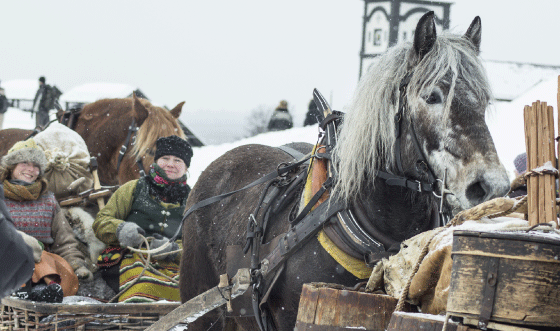
Figure 8.1 Horse-drawn sleighs arriving in Røros – the Dalarna Femund Drivers Association.
Rørosmartnan, an annual winter market, can trace its history back to the mid-19th century and the systemisation of trade in goods. However, Røros Bergstad had been a busy trading post long before that thanks to the copper mines in and around Røros. Nowadays, Rørosmartnan is a trade fair and folk festival where all kinds of people keep their traditions alive. Frozen waterways and snow made transport much easier in the winter than in summer. The historic winter transport route from Tufsingdal over Lake Kornsjøen is part of the Røros Mining Town and the Circumference World Heritage property.
Source Photo: Øyeblikket Foto
8.2 Participation and democracy
Broad participation in all parts of civil society is important for democracy and for individuals. Participation can be exercised individually through non-organised involvement or collectively through participation in organisations and regulated participatory processes.
Individuals, private owners of cultural heritage, foundations, societies and NGOs do a great deal of work to preserve and manage Norway’s cultural heritage. This is done through local groups and associations, which carry out restoration and maintenance work, transfer knowledge and skills, and create activity in and around the cultural heritage asset, to name a few examples. The commitment and dedication of private owners of cultural heritage and volunteers is the main reason why many of the cultural monuments, sites and environments still exist today.
In order to increase participation in the future, it is important to spark an interest in cultural heritage in children and young people today. Schools play an important role in arousing interest, encouraging involvement, and shaping an understanding of history and how it affects society today. The Core curriculum – values and principles for primary and secondary education and training in the new national curriculum Subject Renewal 2020 emphasises that schools shall provide pupils with historical and cultural insight and anchorage. There is considerable potential to make greater use of cultural monuments, sites and environments in schools. Elements pertaining to cultural heritage in “the Cultural Rucksack”, an arts and culture programme in schools, may be one way to raise awareness of, create interest in and encourage involvement in local traditions and cultural environments, or provide insight into other types of cultural heritage. In addition, many museums have long traditions of dissemination activities designed to stimulate curiosity and learning.
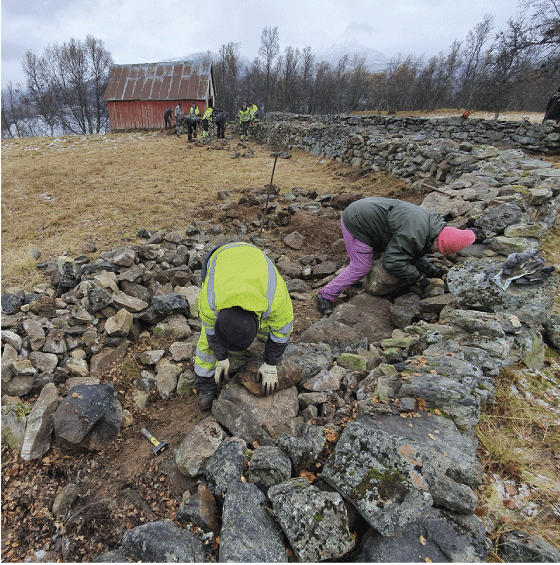
Figure 8.2 Local mobilisation.
Course in dry stone walling in Skallan-Rå, one of the 22 agricultural landscapes of special interest, in the municipality of Kvæfjord. Landowners, skilled craftspeople, bureaucrats and other heritage enthusiasts attended the course. The result was a fully restored 60-metre long dry stone wall.
Source Photo: Cathrine Amundsen, County Governor of Troms and Finnmark
Taking part in skilled crafts and other practical work can arouse interest and involvement. There are many opportunities to get involved in various forms of voluntary or charitable work, for example, during holidays. Voluntary work organised by “friends of” associations or others who help maintain the landscape or repair the buildings are another possibility. An interesting example of this kind of system is the renowned Union Rempart, a French association in the restoration and upkeep of historical monuments and sites. This network was established in 1966 to restore and maintain cultural monuments, sites and environments by connecting volunteers and professional skilled craftspeople with various projects where labour is needed. Opportunities for connecting cultural environment projects and “helping hands” based on the Union Rempart model will be considered as part of the follow-up to this white paper.
World Heritage Centres are places that can promote civic participation. In addition to spreading knowledge and raising awareness about the World Heritage values, the Centres will contribute to the World Heritage having a function in the life of the community in line with the obligations pursuant to the World Heritage Convention. In addition to being a resource for the local community and a meeting place for locals, the World Heritage Centres can thus contribute to increased involvement and local ownership, including through activities in partnership with schools and businesses.
8.2.1 Voluntary work
In the white paper on the voluntary sector in 2018 (Meld. St. 10 (2018–2019)) the government emphasises that volunteering is not a supplement to public services.
The Norwegian government’s Declaration on voluntary work – Declaration on the government’s interaction with the voluntary sector sets out fundamental principles and overarching objectives for the government’s interaction with the voluntary sector. Voluntary activity largely occurs in local communities. The municipal authorities play a central role in strengthening the interaction with the voluntary sector, and several municipalities have established their own volunteering policy.
The overall objective for the government’s voluntary policy is that participation should be broad and widespread. Volunteering is intended to foster engagement and involvement, a sense of community, integration, and cultural awareness. It is also stated in the white paper on volunteering that:
Civic responsibility may stand as a key word for volunteering. Not just social responsibility but also responsibility for the local environment and cultural heritage.
Volunteering is an important arena and meeting place to facilitate people’s right to preserve and take part in their own culture and cultural heritage. Voluntary work also helps safeguard the cultural environment, promote inclusion, and prevent exclusion. It has been demonstrated that cultural environment work can have a significant health impact, and that groups that do voluntary work are important social arenas. A good example of this is voluntary work related to the preservation of historic vessels1.
NGOs
Norway has a high level of voluntary participation by international standards. The Association of NGOs in Norway (“Frivillighet Norge”) has collected key figures on participation and attitudes towards volunteering each year since 2014. These key figures are published in the Volunteer Barometer. The figures from 2019 show that 63 per cent of the population over the age of 15 have taken part in some form of voluntary work during the year. Around nine per cent of these have participated in voluntary work for more than ten hours each month.
Most NGOs in the cultural environment sector are currently organised under the umbrella organisation the Norwegian Federation of Cultural Heritage Organisations (cf. box 8.1).
Figures from the Norwegian Federation of Cultural Heritage Organisations show that volunteers in the Federation’s member organisations contribute about six million hours of voluntary work a year in documentation work, maintenance, dissemination, and passing on their expertise about cultural heritage. The Federation estimates that this work is worth NOK 2 billion.
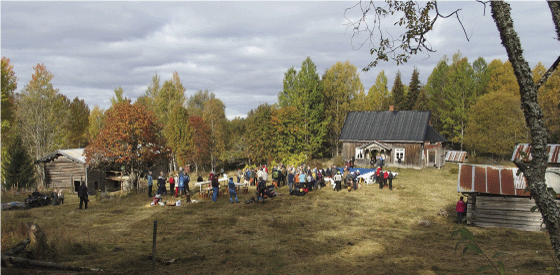
Figure 8.3 Abborhøgda (Yöperinmaki).
The Norwegian state-owned land and forest company Statskog gifted the Forest Finn croft Abborhøgda (Yöperinmaki) in the municipality of Kongsvinger to the National Trust of Norway in 2019. The National Trust of Norway wants to restore the croft, rehabilitate the landscape, and maintain the buildings.
Source Photo: Elisabet Haveraaen, the Ministry of Climate and Environment
Textbox 8.1 The Norwegian Federation of Cultural Heritage Organisations
There is a strong tradition of voluntary work for cultural heritage in Norway. All over the country there are people engaged in societies and associations to help preserve cultural heritage. The Norwegian Federation of Cultural Heritage Organisations is an umbrella organisation for voluntary organisations working within cultural heritage and represents 26 nationwide organisations, with around 2,000 local societies and 250,000 members.
Work performed by NGOs makes a significant contribution to the documentation, dissemination and perpetuation of cultural heritage and ensures it is accessible to all. Volunteers restore and maintain cultural heritage resources and facilitate new use, experience and learning. The passing on of knowledge and know-how is an important part of the organisations’ work. The cultural heritage organisations have specialist expertise in their own fields and are important partners and supporters of museums, archives and the public administration, locally and nationally. In addition, they promote democratisation and learning by providing meeting places and communities where the members can help take care of the cultural heritage themselves.
As of 1 January 2020, the Norwegian Federation of Cultural Heritage Organisations comprised the following member organisations:
National Trust of Norway – Fortidsminneforeningen
Norwegian Heritage Foundation – Norsk Kulturarv
Norwegian Coastal Federation – Forbundet KYSTEN
Norwegian Ship Preservation Association – Norsk Forening for Fartøyvern
Norwegian Lighthouse Society – Norsk Fyrhistorisk Forening
Association for Local History – Landslaget for Lokalhistorie
Norwegian Folk Art and Craft Association – Norges Husflidslag
Norwegian Association for Metal Detecting – Norges Metallsøkerforening
Norwegian Federation of Friends of Museums – Forbundet for Norske Museumsvenner
Genealogy Society of Norway – Slekt og Data
Norwegian Genealogical Society – Norsk Slektshistorisk Forening
Norwegian Federation of Historical Vehicle Clubs – Landsforbundet av Motorhistoriske Kjøretøyklubber (LMK)
Bus Historical Society of Norway – Rutebilhistorisk Forening
Norwegian Historic Aircraft Preservation Association – Landsforeningen for Luftfartøyvern (LFL)
Norwegian Railway Club – Norsk Jernbaneklubb
Norwegian Museum Railway Council – Museumsbanerådet
Norwegian Folk Costume Forum – Norsk Folkedraktforum
Norwegian Flax Society – Norges Linforening
Norwegian Heraldry Society – Norsk Heraldisk Forening
Friends of Norwegian Aquavit – Norske Akevitters Venner
Norwegian Folklore Society – Norsk Folkeminnelag
Norwegian Ship Society – Foreningen SKIPET (Norsk Skipsfartshistorisk Selskap)
The Norwegian Historical Association – Den Norske Historiske Forening (HIFO)
Norwegian Association of Archives – Arkivforbundet
The Norwegian Society of Rural Women – Norges Bygdekvinnelag (associate member in matters involving cultural heritage)
Norwegian Air Sports Federation – Norges Luftsportsforbund (associate member in matters involving cultural heritage)
Source Source: Norwegian Federation of Cultural Heritage Organisations
Many NGOs in the cultural environment sector have a high level of expertise and do a huge amount of work to preserve and disseminate tangible and intangible cultural heritage. This work is of great benefit to the whole of society. The white paper on the voluntary sector in 2018 (Meld. St. 10 (2018–2019)) proposes establishing a new format for dialogue and the exchange of information through a process of issue-specific consultation, called “sakråd”, as a tool in the collaboration between the state and the voluntary sector. Issue-specific consultation is a method whereby the public authorities involved in a specific case can draw on and benefit from NGOs’ specialist expertise. This method will help ensure that the cultural environment authorities make greater use of the knowledge and expertise that the voluntary sector possesses, contributing to more voices being heard and a broader knowledge base.
Textbox 8.2 Traditional boats – construction and use
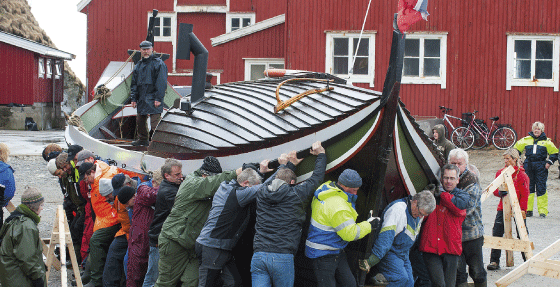
Figure 8.4 Enthusiasts from the Salta Coastal Association put their backs into getting “Nordlendingen” back into the water after a winter on land.
Source Photo: Ernst Furuhatt, Nordland Museum
The Norwegian Coastal Federation (Forbundet KYSTEN) works to ensure that knowledge about the construction and use of traditional boats is safeguarded for the future. The 125 local associations (“coastal associations”) in the Norwegian Coastal Federation keep the knowledge about the use of traditional boats alive through recreational use, leisure activities, and outdoor pursuits. The organisation also arranges special maritime activities and experiences for children and young people. Active use of traditional boats is important to keep boat building know-how alive. The coastal associations can also be credited for the preservation of several hundred old boats that have been given a new lease of life under the motto “Preservation through use”.
A number of coastal associations offer courses in the building, restoration and maintenance of traditional boats. At the national level, a modular series of courses is offered in wooden boat building at upper secondary education level 3, through a joint venture with the Association for Studies of Culture and Traditions and the Norwegian Coastal Federation.
The Norwegian Coastal Federation has received NOK 7.9 million from the foundation Sparebankstiftelsen DNB, to be paid over four years (2018–2022), for local projects all over Norway. The aim is to ensure that knowledge about the construction and use of traditional Norwegian boats is handed down to new generations. This is done by supporting the traditional skilled crafts and through active dissemination of information about the boats that are going to be built.
The Norwegian Coastal Federation is the project manager for a Nordic joint venture project to get Nordic clinker boat traditions inscribed on the UNESCO’s Representative List of the Intangible Cultural Heritage of Humanity. The project started in 2015. The ministries of culture in the Nordic countries have decided to submit the nomination.
Source Source: Norwegian Coastal Federation – Forbundet KYSTEN
8.2.2 Public Participation
Public participation and co-creation are important for cultural environment management. In order for citizens to experience getting involved as engaging, relevant and useful, it is essential that the methods and tools used are tailored to the target audience. New technology opens up many opportunities in this context. Folketråkk is a digital platform with information to support municipal authorities, planners and politicians in their work to involve citizens in local development. The platform provides an overview of various methods and tools ensuring that everyone has access to and can influence planning processes. A special participatory platform has also been developed for children and young people. Barnetråkk is a digital tool and teaching programme focusing on the needs of children and young people in planning.
Many municipal authorities have excellent citizen involvement and participation processes in connection with their planning work, ensuring that the local population is included. Examples of methods used include the appointment of citizen panels, planning charrettes, different types of meetings, and the use of a wide range of digital tools.
The Directorate for Cultural Heritage’s project Kulturminner i kommunene [Cultural heritage in the municipalities] has focused on collaboration with the local population and NGOs. In the work on municipal cultural heritage plans, the municipal authorities have been able to draw on the knowledge, overview and commitment that exist in local communities (cf. box 9.8).
The use of digital tools can create new, larger arenas for participation and co-creation. In the Directorate for Cultural Heritage’s online search portal “Kulturminnesøk”, the general public, users and volunteers are invited to get involved and contribute their knowledge, photos and stories. As of 1 January 2020, approximately 30,000 images have been uploaded (cf. section 8.3.2 and figure 8.7).
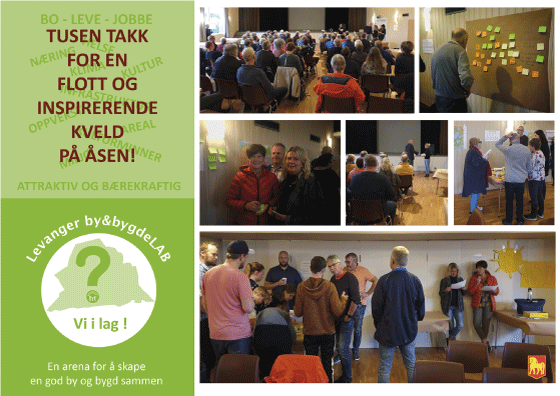
Figure 8.5 Local participation and collaboration
Citizen participation through “town hall” meetings (“ByLab”) can be organised as a regular forum in fixed premises, as an ambulatory service, as a temporary offering in various locations, as a digital platform, or as a combination of the above. The three towns in the Innherred region of Norway – Steinkjer, Levanger and Verdal – have established a “town hall” forum (“ByLab”) and are focusing on the role of nature and cultural heritage in urban development. In Levanger, “town hall” forums have been established at four locations in the municipality: Åsen, where these images are from, Skogn, Ytterøy and town centre.
Source Photo: Trine Hansen Blomquist and Tove Nordgaard, Levanger Municipality
8.3 Accessibility
Digital solutions are important instruments for fostering citizen involvement and participation, enabling everyone to have the opportunity to get involved in and assume responsibility for the cultural environment. Although digital documentation can never replace the real thing, digital documentation methods and various digital solutions can be important tools in the work to preserve knowledge, ensure accessibility, and engender participation. In some cases, it is not possible to preserve a cultural monument, site or environment physically and/or in situ. In these kinds of cases, digital documentation may be the only option to preserve knowledge about it and allow people to experience it. Digital dissemination solutions are also a way to make cultural monuments, sites and environments universally accessible to people who for various reasons cannot visit places, buildings and facilities in person.
8.3.1 Digital dissemination
Technology provides a number of new opportunities for dissemination. Digital visualisation methods such as augmented reality (AR), virtual reality (VR) and 3D models can provide better, more user-friendly solutions for dissemination and knowledge sharing in the cultural heritage sector going forwards. These kinds of presentations enable communication about details and contexts and allow users to move around inside buildings, environments and landscapes that might be difficult to access in real life due to geographical factors or their state of repair (cf. figure 8.6).
For example, several of the clusters of buildings from whaling activities on the island of South Georgia in the Southern Ocean have been 3D scanned. In this way, cultural environments from an important chapter in Norwegian history that are inaccessible to most people due to their location have been documented and made available. Another example is the interactive presentation The Port of Oslo 1798. Here you can experience the sights and sounds of the Port of Oslo in a digital world. It is also firmly linked to the physical world through scent boxes placed at specific locations along the Harbour Promenade in Oslo. In connection with the archaeological excavation of St Clement’s Church in Trondheim, 3D models were created and shared to convey information from the excavation as it progressed.
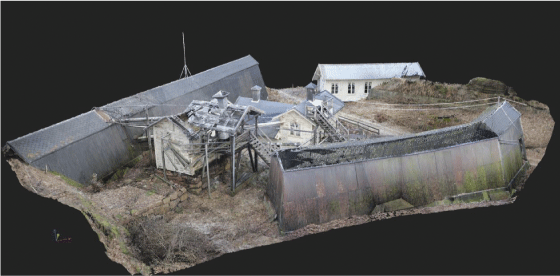
Figure 8.6 Digital reconstruction of the Engene explosives factory in Hurum.
Engene explosives factory is probably the last remaining factory of its kind in the world. Parts of the plant are going to be protected. However, the oldest part of the plant poses such a high safety risk that it cannot be preserved and must be demolished. The entire Engene explosives factory has been well documented, meaning the area can be reconstructed using virtual technology or included in a future museum or visitor centre in some other way.
Source Source: The Norwegian Institute for Cultural Heritage Research (NIKU)
Data from cultural-historical investigations can also be used in other, less traditional contexts, such as films and games. This can help to create interest and involvement in the cultural environment among new audiences. There is great untapped potential in joint ventures between commercial players and museums, archives, research institutions, etc., that ought to be explored at greater depth. However, high production costs and large volumes of data mean that the use of digital reconstructions is currently somewhat limited. The development of good dissemination solutions in the future will depend on closer collaboration between relevant actors in this area.
8.3.2 Cultural environment data
Large amounts of cultural environment data exist, and there is potential for huge gains through collaboration on structuring and organising this data, including efficient sharing of open data, leading to better digital solutions for audiences. However, there is also a marked need for better coordination of storage systems and solutions.
A number of partnerships and joint projects have already been established across institutions and sectors. For example, users of the Directorate for Cultural Heritage’s database “Askeladden” can access information about archaeological finds from the archaeological museums’ collection databases.
“Kulturminnesøk” is the Directorate for Cultural Heritage’s digital dissemination service. It contains information on over 190,000 cultural monuments, sites and environments: protected buildings, technical and industrial cultural heritage, protected cultural environments, World Heritage properties, churches, archaeological monuments and sites, state-owned properties of cultural-historical value, vessels protected by law or other measures, and underwater cultural heritage, as well as additional information provided by the public. In Kulturminnesøk, anyone can enter information about and upload images of the cultural environment (cf. figure 8.7). It bears a close resemblance to the museum sector’s “KulturPunkt” portal, and the entire cultural heritage sector would benefit from better coordination and linking of the various solutions.
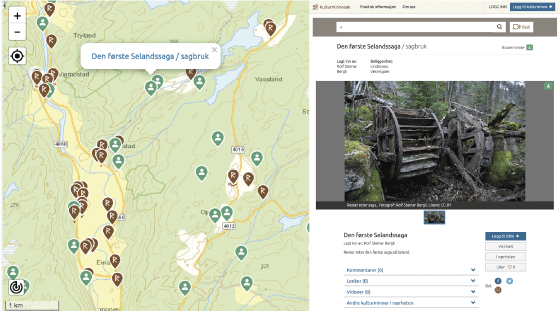
Figure 8.7 Example from the Kulturminnesøk portal.
The first sawmill at Seland (“Den første Selandssaga”) in Lindesnes municipality is a user-entered item in the Kulturminnesøk portal, i.e., a cultural monument or site that has been entered by a private individual. In Kulturminnesøk, anyone can enter information and upload images, as well as search for place names, types of objects, or explore places directly in the map. Each entry has information about the cultural monument, site or environment, its protection status, and, as applicable, photographs and other images.
Source Source: Kulturminnesøk
The follow-up to this white paper must pave the way for a greater degree of sharing and coordination of data and digital solutions. This will contribute to more collaboration and better coordination of work done under the auspices of the Ministry of Education and Research, the Ministry of Culture, and the Ministry of Climate and Environment. In this work, importance should be attached to underlining the links between tangible and intangible cultural heritage (cf. section 10.3.2).
Data sharing is also of great importance to owners of cultural heritage. It must become easier for owners to access all the data that is relevant to their property, regardless of whether the property is protected or whether it is situated in an area with high conservation value, for example. A variety of different ways of providing access to this kind of information must be considered.
8.4 Better framework conditions for owners of cultural heritage
Private owners of cultural monuments, sites and environments do invaluable work to preserve an important part of Norway’s cultural heritage, benefiting everyone.
In the vast majority of cases, continued use is the best way to preserve cultural monuments, sites and environments. Without owners who see the usefulness of using a building or other structure or continuing farming in an agricultural landscape, many items of cultural-historical value will be at risk of disappearing.
Many people are proud to own a protected or historic building or object, at the same time as these kinds of properties are subject to stricter regulations than other types of property. It is therefore important that the cultural environment authorities have good dialogue with owners and provide advice and guidance. Advisory services and grants are key policy instruments in enabling everyone to take their share of the responsibility. In its circular on the processing of applications for exemption2, the Directorate for Cultural Heritage emphasised that the management of cultural environments should be solution-oriented in interaction with users and owners, and that protection should not be a hurdle to the continued use of a building, rather it should help ensure its use as far as is possible.
8.4.1 Traditional crafts
Knowledge about traditional crafts and materials is essential to be able to preserve protected and historic buildings, facilities, vessels and other cultural heritage. Skills and know-how in old crafts and knowledge of traditional materials provide a different kind of historical insight to academic knowledge. Skills and know-how in old crafts and knowledge of traditional materials are also essential to understanding how and why buildings, structures and vessels have been constructed and repaired. Transfer of knowledge from experienced artisans is particularly important, and this kind of learning – be it in individual companies specialising in particular skilled crafts or in formal courses of study – is an important element in ensuring the perpetuation of old skills and knowledge.
There is a need for broad expertise in traditional crafts to preserve and maintain a diverse cultural heritage. There is a need for expertise in old craft techniques and knowledge of traditional materials, but knowledge of newer building materials, such as masonry and concrete, is also necessary in order to be able to preserve cultural monuments, sites and environments from more recent eras. It is important to ensure old craft skills are not lost for industrial-political and cultural reasons. This can be done through formal education, transfer of knowledge in joint projects, and apprenticeship schemes. This is an important part of the implementation of the Convention for the Safeguarding of the Intangible Cultural Heritage.
In response to the white papers on the management of cultural heritage in 2005 and 2013 (St.meld. nr. 16 (2004–2005) and Meld. St. 13 (2012–2013)), several educational programmes in traditional crafts and artisanship have been established in the last five to ten years. For example, the Norwegian University of Science and Technology (NTNU) offers a bachelor’s degree programme in traditional building techniques, from which the first cohort graduated in spring 2018. Graduates from this programme of study will be qualified to work on restoration assignments and perform other tasks within cultural environment management.
The vocational schools in Innlandet, Hordaland and Vestfold and Telemark have established, or are in the process of establishing, programmes in traditional crafts and restoration. These are modular courses that practising skilled craftspeople can take while they are in work and provide a good basis for work on restoring protected buildings and buildings worthy of preservation.
The county authorities’ responsibility for cultural environment management and upper secondary education ought to be better coordinated with a view towards establishing educational programmes that are adapted to the different regions.
Maintenance of vessels protected by law or other measures requires specialist skills and expertise. Due to the developments in technology, these kinds of skills and expertise are almost entirely absent in commercial shipyards nowadays. Relevant training for this type of skilled work ought also to be linked to the vocational schools, as is the case for other education in skilled traditional crafts. It may also be pertinent to get the ship preservation centres involved in this.
The museums play an important role in keeping the various traditional crafts alive, both by providing a market for them and as bearers of traditions. Several museums have specialised in certain materials and modules and offer their skills to other museums. The National Museum Network comprises 61 museums that together manage some 5,000 cultural-historical buildings. The collections also contain furniture, tools and other objects, as well as a number of vessels. Much of the maintenance work requires extensive use of old types of material and craft techniques. Many museums include this work as part of the dissemination at the museum.
The refurbishment market, which includes restoration, renovation, conversions and extensions, was estimated to be worth NOK 178.7 billion per year in 2018.3 Figures have not been calculated for the refurbishment of protected and historic buildings, but this is clearly a large market, involving large sums of money, which looks set to continue growing in the future.
There is growing interest in redeveloping existing buildings, to adapt them for new or different uses. This includes conversions, renovations, additions, extensions and infills. There is a growing number of architects, consultants, construction companies and skilled craftspeople that specialise in cultural-historical buildings. The interest and experience these companies acquire through working on this type of project, ideally in close collaboration with cultural environment authorities, are important to raising the profile and boosting the expertise and knowledge of traditional crafts within the sector. This applies to all phases from planning, through the application process and design, to actual construction.
Textbox 8.3 Cultural heritage for everyone
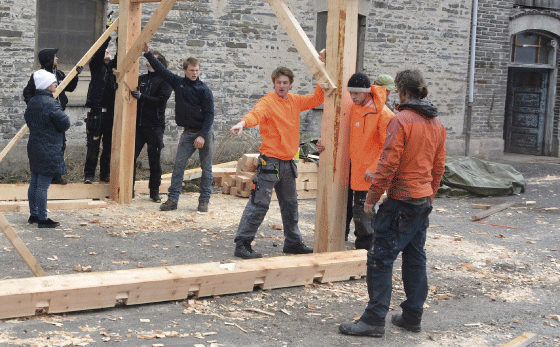
Figure 8.8 Engaged participants at the National Trust of Norway’s workshop in Bergen in 2018.
Source Photo: Lars Erik Haugen, the National Trust of Norway
Cultural heritage for everyone is a five-year programme under the auspices of the National Trust of Norway. The programme started in 2016 and is fully funded by the Sparebankstiftelsen DNB foundation. It is the spearhead of the National Trust of Norway’s work to preserve intangible cultural heritage. In addition to ensuring the restoration of cultural monuments, sites and environments, the goal is to contribute to the transfer of know-how and expertise in traditional crafts, especially to younger skilled craftspeople.
Experience shows that many restoration projects are postponed or delayed due to a shortage of skilled craftspeople with expertise in older building traditions. Cultural heritage for everyone helps to entice more people into an education in traditional crafts through dissemination and transfer of expertise.
Cultural heritage for everyone has established a resource group of relatively young practitioners of traditional skilled crafts (aged 30–45 years), who receive training in teaching traditional crafts. These people are then used to give talks and hold courses at workshops, or at seminars linked to specific restoration projects that receive grants.
Each year NOK 5 million is awarded for restoration work. The funds are awarded through an application process. An important criterion for receiving support is that the project creates an arena for the transfer of expertise in traditional skilled crafts. Through the grant scheme, courses are arranged in various craft techniques, for local skilled craftspeople, school children, and groups of enthusiasts and volunteers.
In addition, a scholarship scheme has been created, which each year awards a scholarship to four young practitioners of traditional skilled crafts. The winners participate in courses at the wood craft centre Treseminaret in Hjerleid in Dovre and at the Håndverksdagene [“craft days”] conference in Røros. This provides knowledge and inspiration, as well as helps build up a network among practitioners of traditional skilled crafts from all over Norway.
Each year Cultural heritage for everyone conducts several workshops for young skilled craftspeople. The purpose is to bring together school children and young skilled craftspeople for a week’s course in traditional crafts and artisanship.
Source Source: The National Trust of Norway
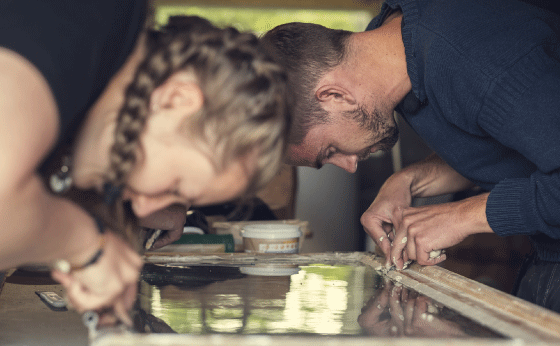
Figure 8.9 Course in window restoration in Å in Lofoten, organised under the auspices of the National Trust of Norway.
Source Photo: Bård Gundersen TUN media / The National Trust of Norway
8.4.2 Consultancy services
Good information and guidance are important for the individual owner of protected and historic buildings, structures, vessels and other cultural monuments, sites and environments. Owners of cultural monuments, sites and environments need access to advisory services, skilled craftspeople and technical expertise in order to be aware of the rules and guidelines that lay constraints for works they may wish to undertake.
For example, the Directorate for Cultural Heritage’s 15 priority technical and industrial facilities have ties with relevant skilled craftspeople. These individuals have built up important expertise in the preservation and restoration of technical and industrial cultural monuments, sites and environments. It is important that the expertise gained from working on these facilities is maintained and shared with other relevant groups of skilled craftspeople.
Another important project that has resulted in a competence cluster is the restoration work in connection with Nidaros Cathedral, which is the national centre of excellence for the preservation and restoration of stone buildings deemed worthy of preservation. In addition to restoring and maintaining Nidaros Cathedral and the Archbishop’s Palace, the centre of excellence shall also ensure the preservation and perpetuation of the traditional crafts and artisanship represented at the centre. Traditional, internal further education of skilled craftspeople has been combined with a bachelor’s degree in technical building conservation at the Norwegian University of Science and Technology – NTNU (cf. box 8.4). The team working on the restoration of Nidaros Cathedral also offers general advice on the restoration of historic stone buildings deemed worthy of preservation, the preparation of condition and treatment reports, supervision of apprentices in skilled crafts, and various courses and lectures.
Building preservation centres
Building preservation centres and other advisory services for building preservation are of great importance for practical restoration and maintenance work. They act as an easily accessible offering for owners of cultural monuments, sites and environments and skilled craftspeople alike and play a key role in ensuring access to expertise in traditional crafts and artisanship. According to the Directorate for Cultural Heritage, the applications submitted and the outcomes of restoration and maintenance projects are of a higher quality in counties that have already established building preservation centres or other similar advisory services for owners of protected buildings and buildings worthy of preservation.
The government will consider providing start-up grants to stimulate the establishment of these kinds of advisory services. Services can be established according to a number of different models, where, for example, the cultural environment authorities partner with museums and other actors to meet local needs and regional adaptations.
There is a particular need to follow up owners of automatically protected Sami buildings. The project Registration of automatically protected Sami buildings in the conservation programme Sami cultural heritage has resulted in the registration of some 900–950 automatically protected buildings (cf. box 10.1). Many of the owners have recently been made aware of the protection status of their property and need information and guidance on the implications of owning a protected building.
Textbox 8.4 The Oppland model for building preservation
The Oppland model for building preservation is an example of a regional advisory service. The service consists of an adapted continuing education programme / bachelor’s degree programme in traditional building techniques and a scheme for free advice on technical matters in connection with construction work on protected and historic buildings. As a result of the Regional Reform, the scheme is now being expanded to apply to the whole of the new county Innlandet and is therefore changing its name to the Innlandet model.
The continuing education programme / bachelor’s degree programme is a collaboration with the Norwegian University of Science and Technology (NTNU), mainly offering training in carpentry, but also in traditional masonry, metalwork and painting techniques. The teaching takes place at various venues around the county, often linked to the regional museums, and the practical training includes work on real restoration projects.
Over a ten-year period, a network has been built up consisting of five building preservation advisers. Four are employed in the regional museums: Mjøsmuseet AS, Randsfjordmuseet AS, Gudbrandsdalsmusea AS and Valdresmusea AS. The fifth is based at Maihaugen and provides services on an assignment basis. The building preservation advisers provide services for external parties, offering professional advice and guidance to their target groups. The main target groups are owners of protected buildings and buildings worthy of preservation, museums, and the municipal authorities’ administration in cases where protected buildings and buildings worthy of preservation or cultural environments are affected. Free advice and guidance are provided on relevant repair and restoration measures, and assistance can be provided in connection with applications for grants. The advisory service has an upper limit of one day’s work. The building preservation advisers also provide professional input and advice to the regional cultural environment authorities.
In addition, the advisory service has an important awareness-raising role and conveys knowledge about work on historic buildings to the general public, including through courses, public meetings on specific topics, and active use of media. They also contribute to providing inspiration and information to school children and skilled crafts workers about work on historic buildings and the opportunities for education.
Source Source: Innlandet County Authority
Ship preservation centres
In 1996, three national ship preservation centres were established: Hardanger Maritime Centre (Hardanger fartøyvernsenter – HFS) in Norheimsund, the North Norwegian Ship Preservation Centre and Boat Museum (Nordnorsk fartøyvernsenter og båtmuseum – NNFA) in Gratangen, and Bredalsholmen Shipyard and Preservation Centre (Bredalsholmen dokk- og fartøyvernsenter – BDF) in Kristiansand. HFS and NNFA work on wooden vessels, while BDF works on steel vessels. HFS is part of the Hardanger and Voss Museum, while the other two centres are independent foundations.
The ship preservation centres play an important role in the practical preservation of historic vessels and the quality of restoration and repair work. It is a goal that the ship preservation centres will act as low-threshold facilities for owners of vessels with cultural-historical value and skilled craftspeople at other shipyards and boat building companies, and that they will continue to play an important role as hubs providing access to and sharing knowledge and expertise in traditional crafts.
The centres carry out joint services and concrete restoration and repair assignments on vessels. Joint services are activities intended to ensure that skills and know-how related to the maintenance and restoration of wooden and steel vessels are preserved in a long-term perspective. A system must be put in place to ensure these skills can be preserved independently of economic fluctuations in society. The grant that the ship preservation centres receive for joint services is not operational support, but funding for the purchase of services related to the documentation, competence building and other services that ordinary shipyards cannot be expected to provide.
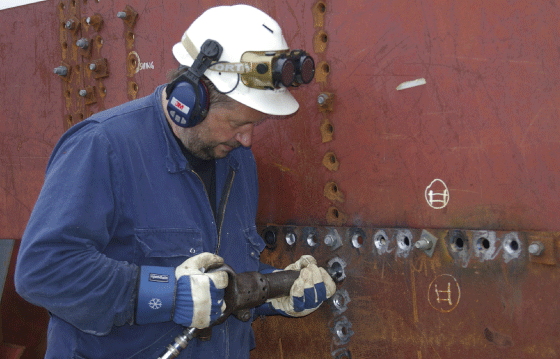
Figure 8.10 Riveting a steel vessel at Bredalsholmen Shipyard and Preservation Centre (BDF).
Source Photo: Elisabet Haveraaen, the Ministry of Climate and Environment
The Directorate for Cultural Heritage made extensive changes to the administration of the grants for the ship preservation centres in 2015, and in 2017–2018 the Directorate for Cultural Heritage conducted an evaluation of the ship preservation centres. The evaluation revealed a need for closer monitoring of the centres’ productions and deliveries. The Directorate for Cultural Heritage and the ship preservation centres have established a joint project to follow up the recommendations ensuing from the evaluation. This work is still ongoing.
Collaboration and exchange of knowledge between local groups of skilled craftspeople and the three national ship preservation centres is essential. The county authorities, the Sami Parliament and the municipal authorities play a central role in facilitating this kind of collaboration.
“Bygg og Bevar” – the Portal for Building and Restoration Advice
Organised as an online portal, “Bygg og Bevar” is a collaborative programme between the Ministry of Climate and Environment and the Building Industry Association (BNL). The programme was established in 2009, as part of the response to the white paper on the management of cultural heritage in 2005 (St.meld. nr. 16 (2004–2005)). The affiliation with the Building Industry Association (BNL) ensures the skilled work industry has close ties to work on buildings deemed worthy of preservation, making it an excellent arena for public–private partnerships.
The “Bygg og Bevar” Portal for Building and Restoration Advice makes knowledge about the construction, restoration and maintenance of old buildings accessible to everyone. The portal functions as a meeting place for homeowners and skilled crafts workers with, among other things, concrete tips and instructions on materials, building structures, restoration of windows, and improving the energy efficiency of existing buildings, without compromising the heritage value of the buildings.
The collaboration between the cultural environment authorities and commercial players provides many opportunities to work towards the national climate action ambitions and create good building environments where cultural-historical values are integrated and preserved. In addition, knowledge related to crafts and regional building practices is maintained.
The “Bygg og Bevar” programme expires at the end of 2020. The programme’s ability to contribute to a green, sustainable construction industry through the reuse of existing buildings, good craftsmanship and traditional materials will continue to be important. The follow-up to this white paper will include assessing continuance of the “Bygg og Bevar” programme with a long-term, predictable framework. It ought to be a goal that any continuation of the “Bygg og Bevar” portal retains close ties to the construction industry.
8.4.3 The Cultural Heritage Fund
The Cultural Heritage Fund is a grant scheme for private owners of cultural monuments, sites and environments deemed worthy of preservation. It will play an important role in the work towards attainment of the goal that everyone shall have the opportunity to get involved in and assume responsibility for the cultural environment. Preservation through use and value creation are important criteria in the Cultural Heritage Fund’s assessment of applications for funding. In this way, income can be generated that in turn enables the owners to keep the cultural heritage alive.
The Cultural Heritage Fund was established in 2002, and over 16 years it has provided support for over 5,000 projects throughout the country. Four out of five recipients of funding report that their project would not have been completed without support from the Fund.
Each year, the funding applied for is far higher than the available budget. In 2018, for example, the fund had NOK 92.7 million available for distribution, while in the same year applications for funding for projects totalled almost NOK 345 million.
A report from Menon Economics in 2017 on the benefit to society of the Norwegian Cultural Heritage Fund4 demonstrates that grants for cultural monuments, sites and environments trigger funding, involvement and work from the owners, volunteers and others. This creates positive ripple effects beyond the preservation itself, such as direct and indirect commercial opportunities, development of skilled crafts workers and artisans, rising property values, local development, and better experiential qualities in landscapes and urban spaces. According to the report, the grants issued by the Cultural Heritage Fund, which amount to NOK 570 million since it started operating in 2003, have resulted in the injection of private funds totalling almost NOK 2 billion in the preservation work. In other words, each Norwegian krone (NOK) of grant funding from the Cultural Heritage Fund leads to NOK 3.50 being spent on preservation projects.
The Cultural Heritage Fund has proven to be a good tool for preserving a diversity of cultural environments that do not have protected status. The government plans to continue strengthening the Cultural Heritage Fund and ensure that the money it administers contributes strategically to the attainment of the national cultural environment goals.
Textbox 8.5 The Ilsvika steam power station in Trondheim
The disused Ilsvika steam power station in Trondheim has been repurposed as a fitness centre.
This landmark building was originally built as a backup power plant for Trondheim Elektrisitetsverk in 1915. The plant consisted of an apparatus department, boiler house, coal bunker, two diesel-powered generators, and a machine room. During the Second World War, the Germans used the coal bunker to delouse soldiers and prisoners.
The characteristic gates were in very poor condition, and the restoration work was supported by the Cultural Heritage Fund with a grant of NOK 265,000. The owners Hilde and Morten Holck received the Cultural Heritage Fund’s national plaque for good conservation work.
This project is a prime example of the conversion and repurposing of large urban buildings, while preserving historic building components. The steam power plant demonstrates preservation through use, where the building benefits the general public and contributes to social sustainability.
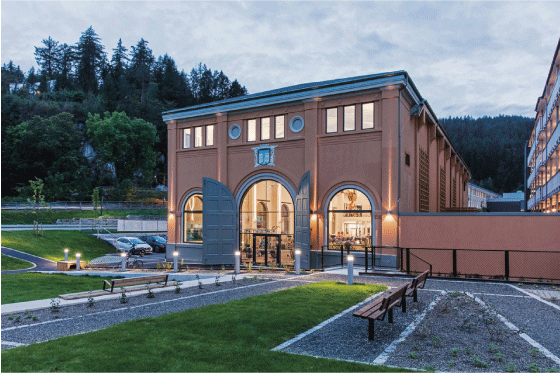
Figure 8.11 The steam power station with open gates after restoration.
Source Photo: Benedikte Skarvik / Agraff
8.5 Follow-up
The government will
encourage increased involvement and participation in the management of the cultural environment
This will in part be done by:
making use of the skills and expertise in NGOs
facilitating the sharing and coordination of data
improve the framework conditions for owners and administrators of cultural environments
This will in part be done by:
continuing and developing continuing education for skilled crafts workers in the field of restoration and repair of buildings and ships
considering introducing start-up grants to stimulate the development of regional advisory services for private owners of cultural monuments, sites and environments
considering continuing the “Bygg og Bevar” portal with a long-term, predictable framework
following up the Cultural Heritage Fund in line with the intentions of the Granavolden platform
9 Sustainability
Sustainable development is development that meets the needs of the present, without compromising the ability of future generations to meet their own needs. Norway has adopted the United Nations’ 17 Sustainable Development Goals and Agenda 2030, which are the world’s joint plan of action to end poverty, combat inequalities, halt climate change, and stop the loss of natural diversity by 2030.
The Sustainable Development Goals recognise that environmental, social and economic development are mutually interdependent. This means that the work to achieve the goals must have an integrated approach that encompasses coordination and resolution of tasks at the local, regional, national and international level. Through the Paris Agreement, Norway has committed to work to reduce its greenhouse gas emissions.
The government wants to highlight the importance of the cultural environment for sustainable development through a national goal:
The cultural environment shall contribute to sustainable development through integrated land use and social planning.
9.1 Three-dimensional approach
The UN Sustainable Development Goals reflect the three dimensions of sustainable development: environmental sustainability, social sustainability, and economic sustainability. Efforts in one of the dimensions must not be at the expense of the other two. The follow-up to this white paper will include development of performance indicators that measure the contribution of the cultural environment to the attainment of the Sustainable Development Goals in Norway.
9.1.1 Environmental sustainability
The government has set a target of reducing greenhouse gas emissions by 50–55 per cent by 2030, compared with the level in the base year 1990. To this end, it is necessary to look at how the buildings and construction sector can contribute. Figures from the International Energy Agency from 2013 show that the buildings and construction sector accounts for roughly 40 per cent of the global energy consumption and roughly 30 per cent of global greenhouse gas emissions5. Building materials account for more than 80 per cent of emissions in this sector. The Intergovernmental Panel on Climate Change (IPCC) points out that a large proportion of the buildings that exist today will still exist in 2050, and that the rehabilitation and upgrading of the existing building stock can therefore make a major contribution to reducing the sector’s emissions6. In other words, looking after and ensuring the upkeep of buildings of cultural-historical value and facilities is also an important element in the work to reduce greenhouse gas emissions.
By signing the Convention on Biological Diversity and the Nagoya Protocol, Norway has also committed to halting the loss of natural diversity. Norway’s national targets for natural diversity were presented in the National Budget for 2015 (Prop. 1 S (2014–2015)) and followed up in the white paper Nature for life – Norway’s national biodiversity action plan in 2015 (Meld. St. 14 (2015–2016)). The Intergovernmental Science-Policy Platform on Biodiversity and Ecosystem Services’s (IPBES) Global Assessment Report on Biodiversity and Ecosystem Services indicates that the Sustainable Development Goals for 2030 cannot be achieved based on the current trajectories of biodiversity loss. Preserving the cultural environment and maintaining cultural landscapes can help ensure the survival of endangered species and the types of nature that live here. The initiative Agricultural Landscapes of Special Interest is a scheme that combines a variety of objectives and helps maintain the biodiversity in the cultural landscape (cf. box 10.4).
Climate gains through use, repurposing, reuse/adaptive reuse, and transformation
The transition from a linear economy to a circular economy is a key element in the solution to make the construction industry more sustainable. The goal of the circular economy is to make the best possible use of all the resources. Preservation through use therefore remains an important principle for sustainable cultural environment management. It will result in less waste, as well as reduce the need for production and transport of new building materials.
Textbox 9.1 Calculated greenhouse gas emissions for Villa Dammen
Villa Dammen is a detached house in Moss that was built in 1936. It has been gently upgraded with environment-friendly materials and smart energy solutions that reduce the house’s greenhouse gas emissions. The occupants follow the advice on temperature zoning and reduced heating outside the hours of use, which is easy to implement in this old house.
The decisive factor for energy consumption in housing is the occupants’ behaviour. The measured consumption of energy for the upgraded old house is much lower than energy needs calculated according to standard assumptions (NS 3031). This finding is supported by recent research. Standard calculations of energy needs tend to overestimate the energy needs of older houses and underestimate the real needs of new houses.
In light of this, the Norwegian State Housing Bank has developed an alternative, standardised set of factors that reflect usage that is not uncommon in older houses. The conclusion below is based on these assumptions. The main difference from NS 3031 is reduced operating time for ventilation, lower energy use for hot water, lower temperature outside operating hours, and greater use of temperature zoning.
The calculations indicate that it takes about 52 years for it to be more climate-friendly to demolish an old house and build a new one, rather than upgrade the old building. By contrast, it only takes six months before the upgrade of the old house is more climate-friendly than continuing to use the old building as it was.
The calculations and illustrations are from Asplan Viak. The practical solutions are outlined on the “Bygg og Bevar” Portal for Building and Restoration Advice Jakten på Kilowatten [“Chasing every kilowatt”].

Figure 9.1 Villa Dammen in Moss has been upgraded with environment-friendly materials and smart energy solutions that reduce the house’s greenhouse gas emissions.
Source Source: Asplan Viak, photo: Marte Boro, the Directorate for Cultural Heritage
Continued use, innovative repurposing, and reuse of existing buildings and materials contribute to lower raw material consumption, waste, emissions and energy consumption. These are effective measures that reduce greenhouse gas emissions here and now, as opposed to potentially yielding a theoretical gain in the future.
The concepts of repurposing and reuse/adaptive reuse are closely related and often used interchangeably. Both terms can apply to the use of the entire building, including new uses. They may also refer to the repurposing or reuse of building materials and building components, often in new ways and in combination with new materials with or without processing. Materials and building components that are removed completely from their original context and undergo major changes will not necessarily retain their cultural-historical value. This will vary from case to case, and it is therefore important to be aware of which assets are to be preserved, and choose relevant measures based on this.
Many older buildings were built with high-quality materials that have a long service life and can be repaired and maintained. These are all climate-friendly attributes. The circular economy stresses the importance of knowledge and skills linked to traditional materials and traditional skills. This kind of knowledge is important both to be able to maintain old buildings, and as part of a general development of technological knowledge (cf. sections 8.4.1 and 8.4.2).
Many protected buildings and historic buildings and structures are owned by the state. It is important that the state is an active driving force and sets a good example when it comes to the use, repurposing and reuse/adaptive reuse of historic buildings. If continued use of a building in public ownership is no longer possible, opportunities for other use of the building ought to be explored.
Use, repurposing, reuse/adaptive reuse and transformation can contribute to the preservation of cultural-historical values and the vitalisation of cultural environments. In this context, transformation means the conversion or redesign of areas and buildings. This may involve the transformation of an area to accommodate new functions, such as making new use of former industrial buildings combined with new buildings.
Few studies have been carried out in Norway to measure the climate gains of rehabilitating existing buildings, compared with building new ones. Calculations in connection with the project Bevar bygg – bevar klima [Preserve buildings – prevent climate change] show that reusing existing detached houses results in lower greenhouse gas emissions than demolishing them and replacing them with new buildings (cf. figure 9.2). Calculations presented in a report by Asplan Viak in 20167, commissioned by the Directorate for Cultural Heritage, show that it takes more than 50 years for it to be more climate-friendly to demolish an old building and build a new one in accordance with the current building regulations, as opposed to upgrading the old building (cf. box 9.1).
Calculated greenhouse gas emissions are now increasingly being used both to make good material choices during the construction phase, and to assess demolition and new construction versus conservation and upgrading. The government recognises the need to improve the methods for greenhouse gas accounting to span the entire life cycle of buildings, including demolition, disposal of waste, production and transport of building materials, construction, use and maintenance. It is important that the calculations are based on the actual characteristics of older buildings.
The government wishes to promote the use, repurposing, reuse/adaptive reuse and transformation of historic buildings and building environments through coordinated use of policy instruments (cf. section 10.1.1).
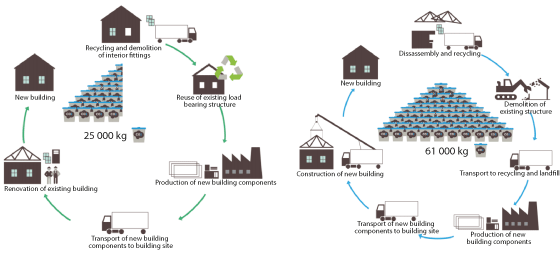
Figure 9.2 Reusing existing detached houses results in lower greenhouse gas emissions than demolition and new construction.
The calculations were performed as part of the project Bevar bygg – bevar klima [Preserve buildings – prevent climate change] and show that emissions associated with the renovation and reuse of a detached house and construction of a new detached house are 25,000 and 61,000 kg of CO2 equivalents, respectively. In other words, reusing the building will result in 61 per cent lower emissions from materials over the lifetime of the building.
Source Source: Rambøll and the project Bevar bygg – bevar klima [Preserve buildings – prevent climate change] (Innlandet County Authority)
Improving energy efficiency and energy-efficient buildings
There is a great potential for improving the energy efficiency of historic buildings. A 2019 research report8 shows that methods used to achieve sustainable new buildings can also work well when restoring and upgrading old buildings deemed worthy of preservation.
Studies carried out by the National Trust of Norway demonstrate that small and medium-sized measures have a major impact in older buildings9. The study found reductions in energy consumption, increased comfort, and reduced emissions of greenhouse gases. It also demonstrated that many of the measures are both affordable and relatively easy to implement.
The standard Conservation of Cultural Heritage – Guidelines for Improving the Energy Performance of Historic Buildings (BS-EN 16883:2017) provides guidance on how to assess and plan energy-saving measures for use in historic buildings without destroying their distinctive character and cultural-historical values.
It is also possible to obtain environmental certification of existing buildings. BREEAM-NOR is a certification scheme aimed primarily at new buildings, but also major renovation projects (cf. box 9.2). The Nordic Swan Ecolabel also offers certification of renovation of existing buildings.
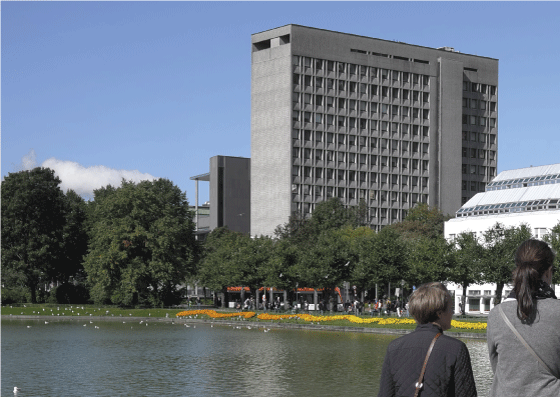
Figure 9.3 Rehabilitation of Bergen City Hall.
Bergen City Hall was designed by the Norwegian architect Erling Viksjø and was built in the period 1971–1974. The building has been designated as worthy of preservation. In 2019, Bergen City Council decided to rehabilitate the City Hall, as opposed to demolishing it and building a new one. The decision was in part based on studies showing that rehabilitation of the existing building would result in 47 per cent lower greenhouse gas emissions than demolition and new construction. The calculations also showed that rehabilitation was the most affordable solution, compared with the demolition and construction of a new building.
Source Photo: Lene Buskoven, the Directorate for Cultural Heritage
In the follow-up to this white paper, the government will attach importance to strengthening the knowledge base related to the environmental impacts of the use, repurposing, reuse/adaptive reuse and transformation of historical buildings. It will also be considered how the current regulations can be adapted to provide opportunities for setting requirements that greenhouse gas emissions must be calculated in projects that may involve the demolition of larger buildings and requirements concerning the reuse/adaptive reuse and transformation of existing buildings in development projects.
Textbox 9.2 The green building industry and a circular approach to buildings
As part of the move towards the green shift, the construction industry is increasingly recognising the value of the existing building stock and is doing important work in developing environmental classification tools.
The Green Building Alliance is an example of cooperation between private and public developers on the one hand and contractors on the other. In consultation with its members, the Green Building Alliance develops and oversees important strategy documents and guidelines that emphasise the value of existing buildings and urban environments. For example, in collaboration with the Green Building Alliance and Grape Architects, the Norwegian Property Federation has prepared the Håndbok i bærekraftig stedsutvikling [Handbook of sustainable local development] (2019) and Think twice before demolishing – Advice on carrying out a successful construction project without demolishing (2019).
Established in 1990, BREEAM (the Building Research Establishment Environmental Assessment Method) is the world’s oldest and Europe’s leading environmental certification system for buildings. BREEAM-NOR is an assessment method specifically adapted to Norwegian conditions. The scheme is market-driven and voluntary. The Green Building Alliance assumed responsibility for certification in Norway in 2019.
“Circular buildings” is a new term in the construction industry. A memo prepared by FutureBuilt, in collaboration with Asplan Viak and SINTEF1 contains a list of suggested definitions, criteria and requirements for circular buildings in FutureBuilt. A circular building shall facilitate resource utilisation at the highest possible level and consist of a minimum of 50 per cent reused and reusable components. It requires good resource utilisation in all the different phases of a building’s lifetime.
1 FutureBuilt criteria for circular buildings, 2019.
9.1.2 Social sustainability
The social dimension of the concept of sustainable development encompasses both social and cultural aspects. Cultural heritage’s potential contribution towards achieving social sustainability lies mainly in the role cultural heritage plays for people’s identity, sense of belonging, quality of life and health for all. Involvement in activities such as maintenance, upkeep, restoration and clearing can be a form of physical activity, provide a richer experience of the cultural environment, and make it attractive to get outdoors. Cultural heritage thus helps build social capital and foster social belonging.
The Ministry of Local Government and Modernisation’s handbook Network of Public Spaces – An Idea Handbook stresses that social sustainability concerns inclusion, reduction of social inequalities, and creating physical places and social conditions where people thrive. Cultural monuments, sites and environments are referred to as “treasure chests” that tell genuine local stories, contributing to identity and a sense of belonging. Cultural historical buildings, sites, facilities, streets, paths and traces in the landscape can be used as a resource in urban and rural development.
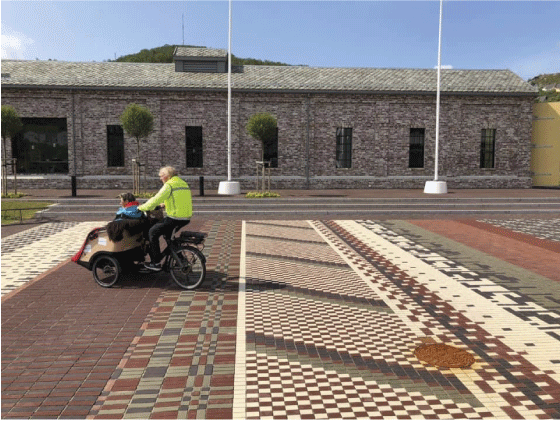
Figure 9.4 Ålgård centre.
The town centre of Ålgård, in the municipality of Gjesdal, received the State Award for Building Quality in 2019. Ålgård centre originally evolved around a wool spinning mill in the second half of the 19th century. The engine shed has been converted into a café and restaurant. The new “carpet” in the centre, with stones laid according to traditional weaving patterns, reflects and underlines its industrial history.
Source Photo: The Norwegian Building Authority (DiBK)
Cultural heritage can provide insight into and knowledge about cultural diversity over time and space. It can contribute to a better understanding of the present and the historical developments that led here, which in turn can build a foundation for greater acceptance of cultural differences. In this way, cultural heritage is a useful resource for integration and inclusion. The county authorities’ increased responsibilities within the area of integration (cf. the white paper on the tasks of the new regions (Meld. St. 6 (2018–2019)) mean they are now better able to coordinate integration efforts with cultural environment management.
Local identity and cultural identity are often closely interlinked. People encounter tangible and intangible cultural heritage in the physical environment, in local stories, and through traditions and language. Knowledge of traditional crafts and knowledge of materials are essential for maintaining and managing tangible cultural heritage (cf. section 8.4.1).
The cultural environment’s potential to increase knowledge, experience and use can make an important contribution to the work towards social sustainability. The cultural environment can help stimulate curiosity and creativity, and it can motivate education and learning. In cases where cultural monuments, sites and environments cannot be preserved, documentation is essential to preserve the scientific values, as a basis for new knowledge. A good understanding of people, culture and society lays the foundation for knowledge about how today’s challenges can be met.
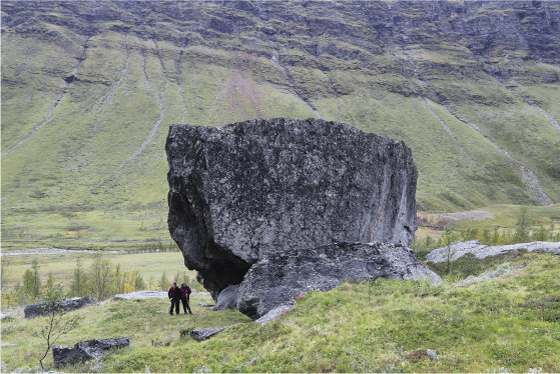
Figure 9.5 Nissonašgállu is a sieidi, a Sami sacrificial stone, in Skardalen / Skárfvággi in the municipality of Kåfjord.
The sieidi is an 8-metre tall block of rock in a high, open location where it is clearly visible from all sides. Originally there was a treasure hide at the foot of the stone where sacrificial offerings were placed, but these have long since been looted. According to local legend, Nissonašgállu will fall on top of anyone who damages the stone.
Source Photo: Oskar Puschmann, the Norwegian Institute of Bioeconomy Research (NIBIO)
Liveable cities and towns
The development of towns, cities and urban areas is part of the solution to achieve sustainable development. The United Nations’ Sustainability Development Goal no. 11, Sustainable cities and communities, is about making cities and human settlements inclusive, safe, resilient and sustainable. Target 11.4 deals with strengthened efforts to protect and safeguard the world’s cultural and natural heritage. The United Nations’ New Urban Agenda10 represents a shared vision for sustainable urban development. It stresses, among other things, the importance of making use of this historic opportunity to leverage the key role of cities and human settlements as drivers of sustainable development in an increasingly urbanised world.
The physical environment defines the framework for people’s lives and quality of life. While the concept of “quality of life” is about the people in the public spaces, “liveability” can be used for the design of surroundings. Liveable cities and towns are settlements that are good to live in, and where the surroundings contribute to a high quality of life.
How cities, local environments and settlements are developed has a huge impact on people’s health. Inspiring surroundings can engender greater physical and social activity, counteract loneliness, and create greater safety. Qualities of the surroundings can also contribute to well-being, better conditions to grow up in, and greater inclusion. The cultural environment can help promote liveability by underpinning a place’s identity and contributing to historical depth of time.
Historic urban environments
Managing historic urban environments and including historic buildings in urban and rural development can contribute to the liveability of a place and enhanced quality of life. It is therefore important that the cultural environment authorities participate in planning processes and urban development projects. Compromises can be achieved through good processes for citizen participation and dialogue. When participating in these processes, the cultural environment authorities are to be proactive, clear and solution-oriented. The cultural environment authorities will work actively to identify valuable cultural environments and the potential for change, as well as specify the limitations and opportunities.
The Directorate for Cultural Heritage’s register of urban cultural environments of national interest, the NB!-register, provides an overview of areas where special consideration must be given in connection with the future management and development.
The Directorate for Cultural Heritage’s Strategy for Management of Norwegian Urban Cultural Heritage 2017-2020 emphasises that today’s cities and towns bear the traces of their history in the layout of their streets, buildings and built environment. A long-term and sustainable management of the historic urban environment presupposes that the buildings are in use and maintained, and that the historic building environments retain their distinctive character and continue to be perceived as attractive living environments. The urban strategy will be further developed with a particular focus on the surroundings’ contribution to liveability and quality of life.
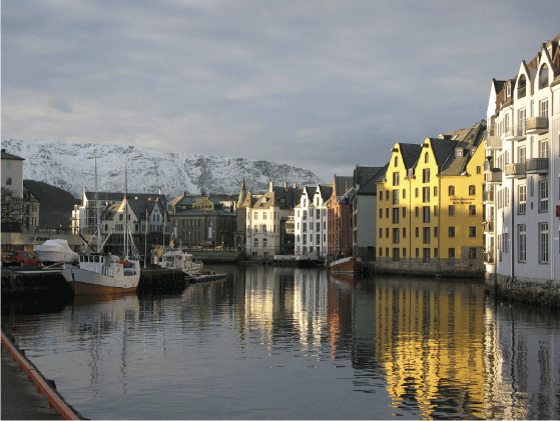
Figure 9.6 Historic urban environment in Ålesund.
Ålesund was ravaged by fire in 1904. The wooden buildings in the town centre were completely destroyed. Shortly thereafter, the town centre was rebuilt in the Art Nouveau style that was in vogue at the time.
Source Photo: Cornelis Horn Evensen, the Directorate for Cultural Heritage
There is often pressure on historic buildings, urban environments, subterranean cultural layers, and other cultural environments deemed worthy of preservation in towns and cities. Population growth in the largest towns and cities necessitates redevelopment and densification, in order to reduce travel distances and avoid building in new areas. In many cases, this can entail challenges for the preservation of cultural-historical assets.
Textbox 9.3 Dialogue forum – exchange of experience and inspiration
In connection with urban and rural development, it is important to ensure experiences and inspiration are shared across municipal boundaries, sectors and levels of government.
Grønn byutvikling – dialogforum med de største byene [Green urban development – dialogue forum with the largest cities] is an informal arena where the government meets political representatives from the cities of Bergen, Drammen, Kristiansand, Oslo, Stavanger, Tromsø and Trondheim. This dialogue forum provides an opportunity to discuss climate and environment-friendly urban planning and development.
Forum for stedsutvikling [Forum for Local Development] is a national, interdisciplinary arena for cooperation among central-government institutions involved in the development of towns, cities and urban areas. The forum aims to strengthen the competencies of the county authorities and the municipal authorities in local development and improve collaboration across sectors and administrative levels.
Textbox 9.4 Historical Trails
The Historical Trails Project is a collaboration between the Norwegian Trekking Association (DNT) and the Directorate for Cultural Heritage. The aim is to breathe new life into old traffic routes and encourage their use. The trails provide opportunities for outdoor activity and increase knowledge about old traffic routes. There are information boards along the trails, in addition to information online about the history of the various routes and the local cultural environment.
There has been great interest in learning about the various cultural monuments and sites along the routes. The number of guest nights spent in cabins along the routes has doubled since the establishment of the historic trails.
Historic trails as of 1 January 2020:
Finnskogrunden – trail passing through several old “Finnetorp” farmsteads and other Forest Finn cultural heritage sites in Kongsvinger
Brudledruta – passing by unique rock formations along an old church road in Sirdal
Jacobineruta – the fjord as a traffic route, with information about wars and the industrial history on the Oslo fjord
Flyktningeruta (“the refugee trail”) – a route used by refugees and couriers during the Second World War, in central eastern Norway
Stølsruta – passing through active summer dairy farms and mountain grazing landscapes in Valdres
Jotunheimen historical hiking trail – the history of the Norwegian Trekking Association (DNT) along the most frequented trails in the Jotunheimen National Park
Telegrafruta – the history of the telegraph and the building of the railways in Saltfjellet
Reisadalen historical hiking trail – with Kven, Norwegian and Sami cultural heritage
The Kamperhamrane trail – the old main traffic artery between western and eastern Norway, from Stryn to Skjåk, featuring shepherding history
The Folgefonna tourist trail – the route taken by the first European fjord tourists across the Folgefonna glacier
Aurlandsdalen – old cattle droving road, with industrial heritage and fjord and mountain cultural landscapes
Historical trails under development:
Hallingskeidvegen – old path to a high altitude marketplace
Malmvegen – mining heritage and transportation of ore in the Rørosvidda mountain plateau
Viglesdalen – Stone Age settlements, ancient burial sites and mountain caves
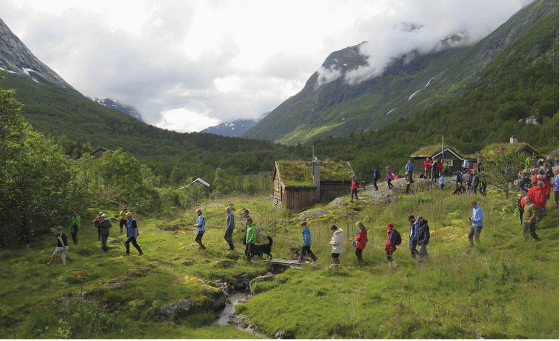
Figure 9.7 The old main traffic artery through the Kamperhamrane mountain pass.
The old main road through the Kamperhamrane mountains runs from Sunndalen in Oppstryn through the Raudalen valley to Skjåk in Gudbrandsdalen. The trail features stone steps and passes large stone landmark cairns. This picture is from Sunndalssetra mountain summer grazing farm in the municipality of Stryn.
Source Photo: Louise Brunborg-Næss, Directorate for Cultural Heritage
The buildings and construction sector and the property industry also have an important responsibility to contribute innovative solutions in development projects as a basis for climate-friendly and socially and culturally sustainable towns and cities.
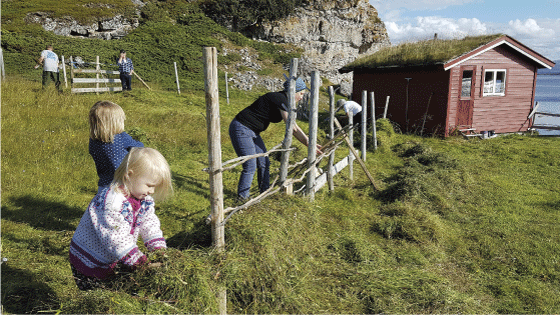
Figure 9.8 A great turn out at the annual Hay Days in Gåradak in Porsanger.
The Hay Days meadow harvesting event in Gåradak in the municipality of Porsanger is organised by Kolvik og Omegn bygdelag, a local rural association. In 2018, around 70 people took part in setting up hay drying racks, harvesting hay with a scythe, and maintaining the cultural landscape at Sivertnes in Gåradak. Hay Days (“Slåttedagene”) is an important social event in a municipality with fewer than 4,000 inhabitants.
Source Photo: Marte Eliassen
9.1.3 Economic sustainability
There is growing awareness of cultural heritage as a basis for value creation.
Cultural heritage’s contribution to economic sustainability
Cultural heritage is a community resource that ought to be exploited to a greater extent to help develop sustainable, liveable local communities and as a basis for business development. Preservation through use has long traditions and is a good strategy for conservation of cultural environments. When a cultural environment is used, new development opportunities may also arise. The Directorate for Cultural Heritage’s pilot project Verdiskapingsprogrammet på kulturminneområdet [Programme for cultural heritage as a resource for local and regional development], carried out in the period 2006–2010 as part of the follow-up of the white paper on the management of cultural heritage in 2005 (St.meld. nr. 16 (2004–2005)) has several good examples of this.
Value creation based on cultural heritage has also been a topic in several development strategies and processes pertaining to both local development and business development. This can contribute to increased support and resources for taking care of the cultural environment. Many of the same experiences have also been reported in the Norwegian Environment Agency’s programme Naturen som verdiskaper [Natural heritage as a basis for value creation].
There has been increased focus on the social benefits of cultural heritage in recent years. In 2014, cultural heritage was recognised by the EU Council of Ministers as a strategic resource for a sustainable Europe. The Report of the Horizon 2020 Expert Group on Cultural Heritage Getting cultural heritage to work for Europe11 states that cultural heritage is increasingly regarded as a positive contributor to European gross domestic product. The report, which was a key underlying document in the EU Framework Programme for Research and Development Work – Horizon 2020, goes on to state that cultural heritage is now widely appreciated as an essential part of Europe’s underlying socioeconomic, cultural and natural capital. According to the report, this represents a significant change in focus in terms of economic policy, as cultural heritage has generally been considered as a cost to society.
The report Cultural Heritage Counts for Europe12 highlighted cultural heritage’s positive economic impact through a collection of examples of best practices. The report points out that cultural heritage has environmental, social, cultural and economic effects at the local, regional and national levels, and that cultural heritage can contribute to the attainment of the Sustainable Development Goals. In recent years, a number of detailed studies have been carried out, with calculations to measure the economic impact of cultural heritage. In autumn 2019, a report from a research and investigation project funded by the European Spatial Planning Observation Network (ESPON) was published. The aim of the project was to collate existing statistics from European countries, in order to create a method as the starting point for a European satellite account for cultural heritage. The method was tested in eleven countries, including Norway. The calculations in the report indicate that the cultural heritage sector made a positive contribution to the economy of NOK 112 billion in 2017, which corresponds to 3.4 per cent of mainland Norway’s GDP.13

Figure 9.9 The importance of cultural heritage for sustainable development.
A visual representation of the impacts of cultural heritage for sustainable development in Europe, from the report Cultural Heritage Counts for Europe.
Source Source: © CHCfE Consortium
Textbox 9.5 “Kulturgarder” – farm tourism based on the cultural environment
“Kulturgarder i Gudbrandsdalen” is a collaboration between farms in Gudbrandsdalen that offer overnight accommodation, food, and a range of activities and experiences. The unique farm environments are the basis for business development. The farms’ history and traditions have been handed down through generations. Overnight accommodation is offered in protected buildings and historic buildings worthy of preservation such as traditional log “stabbur” storehouses and “loft” houses. The goal is to give guests an “unforgettable experience”. Importance is attached to high quality, unique experiences and tailor-made programmes. Culinary experiences are an important part of the concept and are largely based on raw materials from local producers and/or organic products.
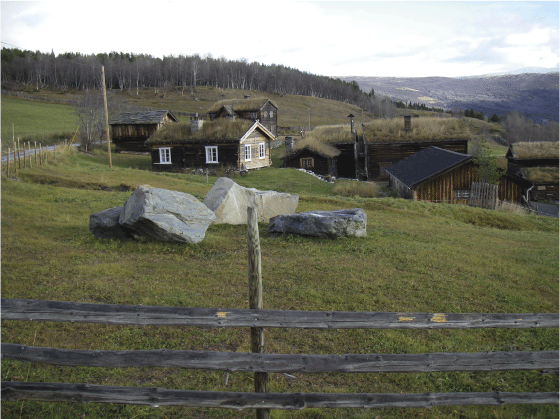
Figure 9.10 Valbjør farm in the municipality of Vågå.
Valbjør farm is one of eight farms in the Kulturgarder in Gudbrandsdalen collaboration.
Source Photo: Elisabet Haveraaen, the Ministry of Climate and Environment
In a study Menon Economics prepared for the Directorate for Cultural Heritage in 2017, methods for calculating the value of common goods and local economic analyses were used to demonstrate the socioeconomic value of a number of cultural monuments, sites and environments14. Among other things, the analysis shows that there is greater willingness to pay to live in a dwelling that is designated worthy of preservation, compared with a similar dwelling that is not worthy of preservation. People are also willing to pay more to live in areas with a high density of buildings worthy of preservation. This is especially true in and near large, contiguous cultural environments. The study shows that living in and near buildings and environments deemed worthy of preservation has value for the individual, but also that the cultural environment contributes to increased prosperity for the local community as a whole in the form of increased employment and value creation through tourism, among other things. These findings are in line with other similar studies from a range of different locations in Europe and the USA.
Business development based on cultural heritage
On commission from the foundation Norwegian Heritage Foundation, Oslo Economics has mapped challenges and bottlenecks related to commercial activities based on cultural heritage15. The report presents a number of proposals for solutions related to regulations, guidelines, and the need for targeted grants linked to the work of both the Directorate for Cultural Heritage and Innovation Norway. As part of the follow-up of this white paper, the proposals in the report will be considered in more detail.
Many cultural monuments, sites and environments in Norway have ties to farming and fishery activities. In order to increase knowledge about and foster interest in Norwegian culinary traditions and sustainable use of raw materials and resources, it is important to preserve physical traces in the environment, such as buildings and equipment used in connection with the production, harvesting, storage, conservation and processing of food and beverages. Examples of this include traditional log “stabbur” storehouses, granaries, mountain summer grazing farms, fish drying racks, and a wide range of tools and utensils.
Any form of business activity associated with the cultural environment must take place in a way that safeguards the attributes of the cultural environment. Use must be sustainable and adapted to the location. The World Heritage Convention is one of the world’s most widespread multilateral environmental agreements and is itself a strong brand within tourism. With their unique qualities, World Heritage properties are expected to manage tourism according to best practices internationally and be good examples for other cultural and natural heritage destinations.
Tourism
Cultural environments are a valuable resource in the context of tourism. According to the United Nations Tourism Organization (UNWTO), cultural tourism around the world is dominated by experiences based on cultural heritage. Cultural monuments, sites and environments can be destinations in their own right; they can elevate the attraction value of a destination, enhance travellers’ enjoyment, and create local business opportunities. Figures from the Menon Economics report in 2017 on the value of cultural heritage10 show that cultural environment tourism contributes 15 per cent of the total value creation in Henningsvær and employs some 20 per cent of the workforce. In Røros, cultural environment tourism contributes 9 per cent of the total value creation and employs 9 per cent of the workforce.
The government wants to pave the way for increased commercial activities and value creation based on the cultural environment. The government’s strategy for culture and tourism16 includes various measures with this purpose. Among other things, the Directorate for Cultural Heritage is going to prepare a guide aimed at commercial players and the government administration and a collection of examples to promote a common understanding of the current rules for use of protected buildings for business purposes. In addition, the Directorate for Cultural Heritage and the Cultural Heritage Fund offer support for the renovation and development of cultural monuments, sites and environments in order to develop a business. Examples of projects include running a hotel in buildings worthy of preservation, farm tourism, and signs in connection with attractions.
Wear damage and overloading are major challenges to the sustainability of cultural heritage tourism. The UN World Tourism Organization (UNWTO) has established ten principles for sustainable tourism that must guide the development of destinations and commercial tourism activities (cf. box 9.6). Innovation Norway has used these ten principles as a starting point for its campaign to promote more sustainable tourism.
As part of its efforts to highlight the potential of the cultural environment to contribute to attainment of the UN Sustainable Development Goals, the government will encourage increased collaboration between the cultural environment authorities and business and industry organisations. Innovation Norway will play an important role in this context.
Textbox 9.6 UNWTO’s ten principles for sustainable tourism
The UN World Tourism Organisation (UNWTO) has established ten principles for sustainable tourism.
Conserving of nature, the environment and culture
1. Cultural wealth
To respect, develop and highlight the historical heritage of the community, authentic culture, traditions character.
2. Physical and visual integrity of the landscape
To preserve and develop the landscape quality, both for cities and villages, so that the physical and visual integrity of the landscape is not degraded.
3. Biological diversity
To support the preservation of natural areas, wildlife and habitats, and minimise the devastation of these.
4. Clean environment and resource efficiency
Minimising the pollution by tourism businesses and tourists of air, water and land (including noise), as well as minimising the generation of their waste and consumption of scarce and non-renewable resources.
Strengthening of social values
5. Local quality of life and social values
Preserving and enhancing the quality of life in the community, including social structures, access to resources, facilities and public goods for all, as well as avoiding any form of social degradation and exploitation.
6. Local control and commitment
Engaging and providing power to the local community and local stakeholders with regard to planning, decision-making and the development of local tourism.
7. Job quality for tourism employees
To enhance the quality of tourism jobs (direct and indirect), including wage levels and working conditions without discrimination based on gender, race, disabilities or other factors.
8. Guest satisfaction and security; Quality of experience
To provide safe, satisfying and enriching experiences for all tourists regardless of gender, race, disabilities or other factors.
Economic sustainability
9. Economic sustainability and competitive tourist destinations through local value creation
To ensure the sustainability and competitiveness of tourist destinations in a long-term perspective, by maximising the value creation of the tourism in the local community, including what tourists leave behind of value locally.
10. Economic sustainability and competitive tourism companies
To ensure the sustainability and competitiveness of the tourism industry in a long-term perspective.
Source Source: UNWTO
9.2 Integrated land use and social planning
The UN Sustainable Development Goals recognise that environmental, social and economic development are interdependent. This means that the work to achieve the Sustainable Development Goals must be based on an integrated approach. Sustainable Development Goal no. 17 emphasises that collaboration is essential for attainment of the goals. This entails obligations for the government administration at the local, regional, national and international levels. Greater use shall be made of the cultural environment as a resource to achieve sustainable social development. This will require increased collaboration and better coordination of instruments.
9.2.1 Regional and municipal planning
Regional and municipal planning are key instruments for promoting sustainable social development throughout the entire country. It is therefore important that the Sustainable Development Goals are integrated as part of the basis for urban and land-use planning.
National expectations regarding regional and municipal planning
In National expectations regarding regional and municipal planning 2019–2023, it is stated that planning is an efficient, effective management tool for sustainable social development and land use. The Planning and Building Act (2008) is the most important tool in this regard. It is a national, cross-sectoral legal instrument that aims to promote sustainable development and good planning processes. Section 1-1 defines the purpose of the Act:
The Act shall promote sustainable development in the best interests of individuals, society and future generations. Planning pursuant to this Act shall facilitate the coordination of central, regional and municipal functions and provide a basis for administrative decisions regarding the use and conservation of resources.
The government has carried out an evaluation of the planning part of the Planning and Building Act17. The evaluation has concluded that the Act largely has high legitimacy and is well balanced with respect to frameworks for key stakeholders but recommends that the links to the various sectoral Acts be improved. In addition, the evaluation points out that the Act ought to attach greater weight to issues pertaining to climate change. The government will use this evaluation as the starting point for its work on considering amendments to the Act. Among other things, it will be pertinent to look at the relationship between the Planning and Building Act and sectoral legislation such as the Cultural Heritage Act.
Textbox 9.7 National expectations related to the cultural environment and landscape
Every four years, the government presents its national expectations regarding the regional and municipal planning, with the goal of promoting sustainable development throughout the entire country. In National expectations regarding regional and municipal planning 2019–2023, the cultural environment and landscape are highlighted in the following expectations:
The county and municipal authorities identify and take into account important natural diversity, areas for outdoor recreation, the green infrastructure, and cultural heritage assets, cultural heritage environments and landscapes in their planning. The combined impacts must be taken into account.
The county and municipal authorities assess land use on the shore line and in and along watercourses in an integrated, long-term perspective, with special regard for natural diversity, cultural environments, outdoor recreation, landscapes and other public interests.
The county and municipal authorities preserve important agricultural areas and pastoral cultural landscapes through long-term development boundaries. Development solutions that can reduce building on farmland are assessed in accordance with the national land protection target.
The county and municipal authorities facilitate high utilisation of space in urban areas through high-quality densification and transformation, with an emphasis on good architecture, urban spaces, cultural environments, green infrastructure and other environmental values in the local surroundings. The location of housing, services, shops, and other workplaces and visitor-intensive enterprises is assessed relative to existing or future public transport hubs.
The municipal authorities give priority to good architecture and quality in the built environment and make plans based on the places’ distinctive features, cultural heritage, and main landscape characteristics. Older buildings and urban structures are regarded as resources in a circular economy.
The county and municipal authorities develop Norway’s World Heritage sites as prime examples of best practice in the management of natural and cultural heritage through land-use planning.
These expectations also apply to Sami cultural environments and landscapes, but there are also two expectations that refer explicitly to Sami interests:
The county and municipal authorities pave the way for a strengthening of Sami languages, culture and economic activity in planning, where relevant.
The county and municipal authorities attach importance to preserving the natural resource base for Sami culture and economic development. Planning safeguards reindeer husbandry areas, while ensuring the needs of reindeer husbandry are balanced against other societal interests.
The Regional Reform and roles in social development
With the Regional Reform, the county authorities have had their role in the regional development strengthened. They have been given increased strategic responsibility and had new tasks delegated in several policy areas, including the cultural environment.
Larger county authorities, decentralisation of tasks, and strengthening of regional planning are key elements of the reform. The purpose of the Regional Reform, as described in the draft resolution on new division at regional democratic level (Prop. 84 S (2016–2017)), is to strengthen the regional democratic level so that the county authorities are better able to fulfil their role in respect of social development.
The county authorities have opportunities to integrate the cultural environment as a resource in several policy areas and make it a relevant factor in social development. The county authorities’ responsibilities include museums, roads, schools and business development, as well as urban and land-use planning. The county authorities are themselves both responsible for the planning at the regional level and advise the municipal authorities in their planning work.
It is important that the cultural environment authorities use the Planning and Building Act as an instrument to ensure the preservation of valuable cultural environments. In the follow-up to this white paper, the opportunities for safeguarding cultural environments of outstanding regional value through the use of regional guidelines and/or regional planning provisions for regional plans will be considered in more detail.
The municipalities’ role
The municipal authorities have been assigned an important role in the management of the cultural environment in that they decide applications for planning and building permits pursuant to the Planning and Building Act. In the processing of applications for planning and building permits, many different interests must be weighed up against one another. It is therefore important that the municipal authorities have access to up-to-date knowledge about the cultural environment in order to be able to make knowledge-based decisions, be aware of the consequences of various interventions, and manage the cultural environment interests in a good way.
Overviews of cultural monuments, sites and environments worthy of preservation in the municipality are useful in the processing of applications for planning and building permits and in dialogue with other sectors that affect land use. These kinds of overviews, such as cultural heritage plans, can contribute to predictability in land-use planning by making information about cultural environment interests available and by increasing awareness of local history. The government recommends that the municipal authorities have updated plans that have broad political support. Protected cultural monuments, sites and environments and those deemed worthy of preservation ought also to be incorporated into the land-use part of the municipal master plan.
In the follow-up to this white paper, the possibilities for safeguarding the cultural environment in existing legislation will be assessed. This applies, among other things, to legal mechanisms that prevent speculative decay in building stock of cultural-historical value. Sometimes the owner responsible for a building deemed worthy of preservation does not undertake the required general maintenance and restoration. Decay due to lack of maintenance may be speculative in order to achieve greater profits than can currently be achieved. The Planning and Building Act has several provisions that provide options for safeguarding the cultural environment, but the municipal authorities tend not to use the instruments provided by the Planning and Building Act to issue orders on the renovation of buildings of high heritage value. According to the municipal–state reporting system KOSTRA, 66 renovation orders have been issued in the period 2015–2018.
Textbox 9.8 Work on cultural heritage at the municipal level
The Directorate for Cultural Heritage’s strategy for cultural heritage work at the municipal level is based on results from the municipal authorities’ work on cultural heritage plans through the Directorate for Cultural Heritage’s project Kulturminner i kommunen [Cultural heritage in the municipalities]. This initiative has involved all the county authorities, a number of museums, hundreds of volunteers, and not least politicians and employees in over 350 municipalities.
The strategy aims to help strengthen the municipal authorities in their efforts to preserve the cultural environment as a resource for knowledge, experience, use and reuse. The strategy clarifies expectations and recommendations for how county authorities and municipal authorities can take action for the benefit of their cultural environments.
The project “Cultural heritage in the municipalities”
The purpose of the Directorate for Cultural Heritage’s project Kulturminner i kommunen [Cultural heritage in the municipalities] was to ensure that as many municipal authorities as possible draw up a cultural heritage plan that has broad political support. The goal was that 90 per cent of all the municipalities would have a cultural heritage plan by 2020.
Municipal authorities wishing to draw up cultural heritage plans have received a lump-sum grant of NOK 100,000 from the Directorate for Cultural Heritage. By 2019, 90 per cent of the municipal authorities had received funding to draw up their own cultural heritage plan.
In the work on a cultural heritage plan, the municipal authorities must obtain an overview of important cultural monuments, sites and environments. The municipal authorities then draw up a plan for their management. The municipal authorities decide what kind of plan they need and define which cultural monuments, sites and environments are worthy of preservation. In many municipalities, historical societies and other NGOs provide assistance in this work. The county authorities and the Sami Parliament follow up with advice and guidance, arrange gatherings, and provide consultation feedback on the plans.
Local directors of cultural heritage management
Several municipalities have a dedicated local office or director of cultural heritage management or a position with similar responsibilities. Some municipalities have established a dedicated specialist department for management of the cultural environment.
In the period 2014–2016, the Directorate for Cultural Heritage conducted a two-year trial scheme to strengthen cultural heritage competencies in the municipalities, with part-financing of local director of cultural heritage management positions in eleven municipalities: Eigersund, Fredrikstad, Frogn, Kongsberg, Kragerø/Risør, Levanger, Lærdal, Moss, Odda and Steinkjer. The majority of the municipalities that participated in the trial scheme have kept these positions.
An evaluation of the scheme, conducted by Oxford Research in 2019, found, among other things, that the trial scheme has contributed to greater awareness and knowledge about the preservation of cultural monuments, sites and environments and their significance. The evaluation also shows that the scheme has contributed to better processing, advice and guidance in connection with applications for planning and building permits. In addition, a lot of interest, activity and involvement have been generated at the municipal level among politicians, owners and businesses, and volunteer groups and NGOs.
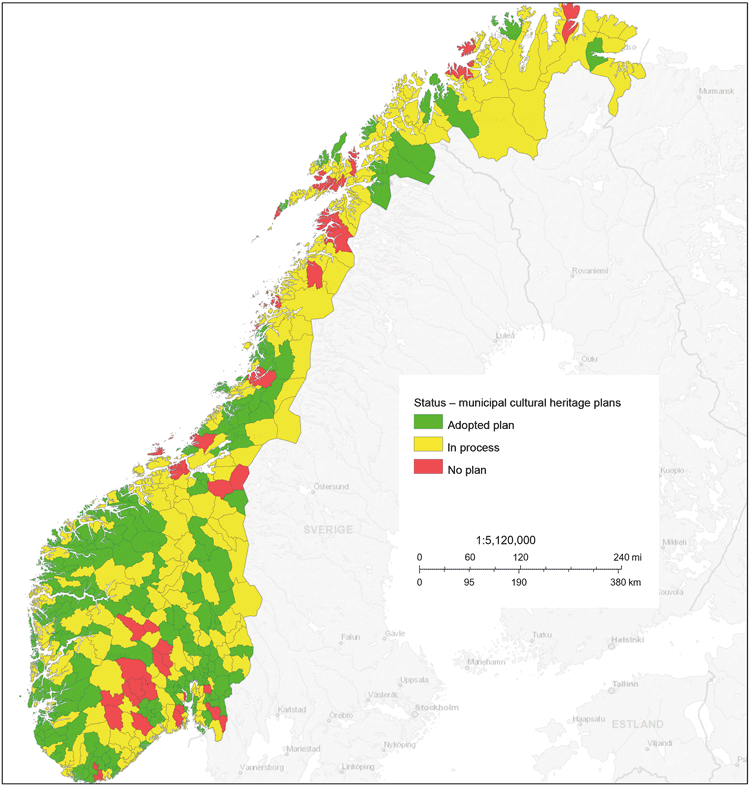
Figure 9.11 Map showing the status for municipal cultural heritage plans in Norway.
Overview of the municipalities in Norway that have adopted a cultural heritage plan (green), are in the process of drawing up a cultural heritage plan (yellow), and municipalities that do not have a cultural heritage plan (red) as of February 2020. This map is based on the municipal boundaries before 1 January 2020.
Source Source: The Directorate for Cultural Heritage
9.2.2 Land-use management
Just over 17 per cent of mainland Norway is protected under the Nature Diversity Act or the Cultural Heritage Act. The success of a sustainable land-use policy depends on a coordinated approach to all land use. The government’s strategy to become a low-emission society by 205018 points out that land use is largely the result of individual decisions, each of which alone does not have major consequences, but which together can have a negative impact on the climate and the environment. The strategy emphasises efficient, sustainable exploitation of already developed land to reduce changes in land use and development of new areas.
Striking a balance between different land-use interests is challenging and demanding. Both at an overarching, national level and in individual cases, it is important that the cultural environment authorities collaborate well with other sector authorities to find good solutions to safeguard cultural environment interests.
All sectors that use land have an impact on the landscape. The responsible sector authorities are thus also responsible for their sector’s impact on the landscape.
It follows from the European Landscape Convention that landscapes shall be managed, protected and planned in such a way that the ecological and cultural historical elements are preserved. Changes to landscapes caused by social, economic and environmental processes shall be regulated and harmonised, with the aim of sustainable development where the residents’ expectations are also met. Overall assessments of the ways in which the various factors are interrelated and the characteristics of the landscape shall be the basis for all national, regional and local decisions that affect the landscape (cf. box 9.7).
Climate-change adaptation
Climate-change adaptation must be given greater priority in public planning. The government’s planning guidelines for climate and energy planning and climate-change adaptation are intended to help avoid or reduce risks, vulnerabilities and negative impacts resulting from changes in the climate. It is emphasised that the county authorities must facilitate climate-change adaptation in all areas of society in their regional plans, and that the municipal authorities must consider how the natural environment and the cultural environment will be affected and how this can be followed up in the social and implementation parts of the municipal master plan. Plans pursuant to the Planning and Building Act and individual decisions that municipal, regional and central-government bodies make pursuant to the Planning and Building Act or other legislation must be based on the guidelines.
With a view to enabling the municipal authorities to assess how the cultural environment will be affected, the cultural environment authorities ought to provide an overview of cultural monuments, sites and environments that are particularly vulnerable to climate change. This kind of assessment has already been carried out for the stave churches (cf. box 9.11), but it ought also to be done for other types of cultural monuments, sites and environments. National bodies, like the Directorate for Cultural Heritage, are responsible for systematising and preparing knowledge for use in planning. Guidance on risk assessment and planning of measures ought to be made available to the government administration and owners of cultural environments (cf. box 9.10).
Textbox 9.9 The environmental authorities’ landscape work
On commission from the Ministry of Climate and Environment, the Norwegian Environment Agency and the Directorate for Cultural Heritage prepared in 2019 a joint proposal for criteria concerning landscapes of outstanding national value.
The objective is that the criteria can be used to identify landscapes of outstanding national value that represent the range and breadth of variation in Norwegian landscapes, in terms of natural diversity, cultural history and the landscapes visual and spatial appearance. The criteria are based on frameworks provided by the Nature Diversity Act and the Cultural Heritage Act, which include constraints and objectives pertaining to landscapes arising from the European Landscape Convention and the Norwegian Planning and Building Act.
This work is a first step towards establishing a common knowledge base for identifying landscapes of outstanding national value. Ten criteria have been formulated in the proposal. They cover landscape values related to natural diversity, which include distinct types of natural landscapes, great natural variation, important ecosystem services, or geological diversity. Furthermore, there are landscapes of high cultural-historical value related to specific activities or historical eras, building practices, different structures, landscapes that are important for ethnic groups, landscapes that are important for social groups, and landscapes linked to specific events, art, faiths and traditions. Landscapes with high general experiential value are also included, as are landscapes with a particularly high combination of cultural-historical and natural diversity values.
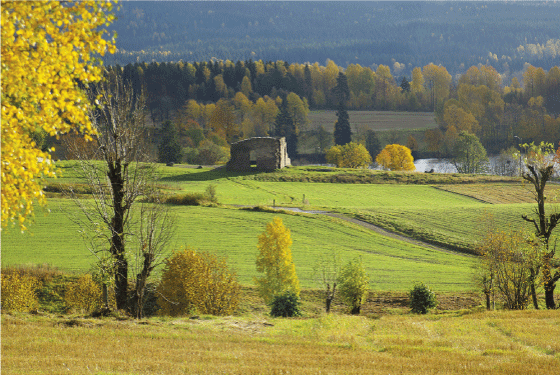
Figure 9.12 Maridalen in Oslo has been designated as a protected landscape area.
The area is of high biological and cultural-historical value and is a widely used outdoor area for the people of Oslo.
Source Photo: Elisabet Haveraaen, the Ministry of Climate and Environment
Textbox 9.10 Adapt Northern Heritage
Adapt Northern Heritage is a three-year collaborative project (2017–2020) involving 15 partners from Ireland, Iceland, Norway, Russia, Scotland and Sweden. The aim is to promote better management of cultural monuments, sites and environments in relation to the environmental impacts of climate change. A changing climate will have major consequences for cultural environments. It will also entail growing challenges for owners and managers of cultural monuments, sites and environments in their work to safeguard tangible cultural heritage.
The project is developing guides on risk and vulnerability assessments of cultural monuments, sites and environments and on the planning of adaptation measures. The guides are being developed, tested and demonstrated in collaboration with the administrators of nine different cultural monuments, sites and environments in Ireland, Iceland, Norway, Russia, Sweden and Scotland. In Norway, two partners have been selected to test and demonstrate the results: the municipality of Aurland and the Governor of Svalbard. In Aurland, the main focus will be on the Aurlandsdalen valley and mountain summer dairy farms. In Svalbard, the focus is on the old mining community in Hiorthhamn.
The project is partially funded by the EU Interreg Northern Periphery and Arctic Programme.

Figure 9.13 Floods and landslides are acute threats that can seriously damage cultural environments.
The Adapt Northern Heritage project is developing tools for dealing with these kinds of incidents. The picture is from Flåmsdalen in the municipality of Aurland.
Source Photo: Marte Boro, the Directorate for Cultural Heritage.
Textbox 9.11 Climate change-related risks to churches
At the end of the Stave church conservation programme in 2015, the Norwegian Institute for Cultural Heritage Research (NIKU) conducted an assessment of the climate change-related risks for all the stave churches in Norway, on commission from the Directorate for Cultural Heritage. The conclusion was that water poses the greatest threat. Two-thirds of the churches will face problems linked to increased biodegradation as a result of climate change, including mould, fungus, and rot due to increased moisture inside and near wood that is close to the ground or foundations. Diverting water from roofs into the ground and ensuring adequate drainage are a challenge. About one-third of the churches are located in or very close to areas that are prone to avalanches, landslides or rock falls.
In 2020, the natural hazards to churches protected by law or other measures are being mapped. The aim is to generate concrete knowledge about the risk of flooding, landslides, avalanches and other types of natural damage to churches protected by law or other measures and inform church owners and municipal authorities that have vulnerable churches about the risks, responsibilities and appropriate measures they can take to reduce the risks. The project will culminate in generalised knowledge about how church buildings can be protected against damage. For the most vulnerable churches, the hazards will be mapped on the basis of the local conditions. Advice will also be provided on appropriate measures that can be taken, with reference to local examples.
The work is being done by the Norwegian Association for Church Employers (KA) and external advisers, in collaboration with the Directorate for Cultural Heritage. Among other things, it is based on mapping of risk using data from the Norwegian Water Resources and Energy Directorate (NVE), the Geological Survey of Norway (NGU) and other relevant data sources, linked to basic data from the Church Building Database.
9.2.3 World Heritage
As a state party to the World Heritage Convention, Norway has clear obligations to safeguard the World Heritage properties on its territory. County authorities and municipal authorities play an important role in fulfilling these obligations. Regional and municipal planning is essential to preserving the assets that won World Heritage status for eight Norwegian World Heritage properties (cf. figure 12.1).
The white paper on the management of cultural heritage in 2013 (Meld. St. 35 (2012–2013)) defined guidelines for the management of Norway’s World Heritage properties and Norway’s work to implement the World Heritage Convention through clear priorities and measures. These include, among others, continuation of the principle that the World Heritage properties shall be developed as beacons of best practice in the management of the natural and cultural environments and giving priority to securing Norway’s World Heritage properties. Importance is attached to clarification of the sectoral responsibilities, coordination of the national policy for the World Heritage properties, and good flow of information between the authorities and the local community. A particular focus on dissemination activities and local support for the World Heritage property is a priority through the ambition to facilitate the establishment of World Heritage Centres at all the Norwegian World Heritage properties. Priority is also given to Norway’s international involvement in and support for World Heritage around the world. Implementation of these measures is well under way, and the current guidelines are to be continued.
Importance will be attached to ensuring transfer of relevant experience from the management of the World Heritage properties to the management of other cultural and natural heritage as a basis for sustainable social development and land use.
The museums play an important role in the dissemination of Norway’s World Heritage with their specialist expertise in dissemination and activities aimed at the public. In connection with the establishment of World Heritage Centres, collaboration with museums has been chosen as the natural solution for the Rock Art in Alta, Røros Mining Town and the Circumference, and the Rjukan-Notodden Industrial Heritage Site.
9.3 Follow-up
The government will
realise the potential of the cultural environment to contribute to sustainable development
This will in part be done by:
developing indicators that measure the contribution of the cultural environment to the the Sustainable Development Goals in Norway
assessing the need for and, as applicable, developing methods for greenhouse gas accounting to span the entire life cycle of buildings
adapting existing grant schemes to promote improvements in energy efficiency and switching to environment-friendly sources of energy in older buildings
adapting the current regulations in terms of requirements concerning reuse/adaptive reuse and transformation
coordinate and clarify the state’s efforts to include cultural environments in the overarching social and land-use planning
This will in part be done by:
using EVAPLAN to look at the relationship between the Planning and Building Act and the cultural environment legislation
assessing the possibilities inherent in the existing legislation to prevent speculative decay
10 Diversity
Norway has traces of human life and activity dating back more than 11,000 years. These traces bear witness to different cultural traditions and historical events. The elements that are preserved should demonstrate the cultural, social and geographical diversity from different eras and help document and explain the historical developments. Surroundings with a rich and varied historical content help make areas attractive and give areas a distinctive identity.
The government wants to highlight this through a separate national goal:
A diversity of cultural environments shall be preserved as a basis for knowledge, experience and use.
10.1 From conservation programmes to preservation strategies
One of the main initiatives in the work to achieve the existing national targets was the establishment of ten conservation programmes. Other important initiatives included developing and implementing the Directorate for Cultural Heritage’s protection strategy and strengthening the work in the municipalities to safeguard cultural monuments, sites and environments deemed worthy of preservation.
Since their start-up in 2007, the ten conservation programmes have mainly focused on improving the state of repair of sites in the selected cultural heritage categories. The protection strategy shall ensure a better geographical, social, ethnic, commercial and historical balance in the portfolio of protected cultural heritage. The work on cultural heritage at the municipal level has contributed to knowledge about and preservation of a broader range of cultural monuments, sites and environments (cf. box 9.8).
Experience indicates that the conservation programmes have been an effective way to organise the conservation work. The conservation programmes, the protection strategy and the work on cultural heritage in the municipalities have all been closely linked to the existing national targets, where priority was given to minimising losses, improving the state of repair, and increasing representativeness. This type of basic safeguarding of cultural historical assets will continue to be an important priority in the management of the cultural environment.
The new national goals, which are much broader and attach greater weight to the importance of the cultural environment for society, will require a change in the focus of the preservation work. While the conservation programmes were primarily linked to financial incentives, there is now a need to take a broader approach to preservation and development, ensuring they elicit support, involvement and dissemination and are firmly anchored in various pieces of legislation. For example, there is a need to assess using a wider range of instruments, not only financial incentives, and to increase collaboration with different sectors.
In order to preserve a diversity of cultural environments, the government will therefore develop preservation strategies for priority topics where all use of policy instruments must be harmonised and coordinated.
Textbox 10.1 The conservation programmes
The Directorate for Cultural Heritage’s conservation programmes, which are an operationalisation of the escalation plan presented in the white paper on the management of cultural heritage (St.meld. nr. 16 (2004–2005)), were established through the treatment of the white paper The government’s environmental policy and the state of the environment in Norway (St.meld. nr. 26 (2006–2007)). Since they started in 2007, considerable work has been done within each of the ten programmes. All ten programmes have been closely linked to the existing national targets, with priority given to efforts to systematically improve the state of repair of the cultural heritage items in the different categories. In addition, importance has been attached to advancement of the sector and knowledge building.
Below is a brief presentation of the goals and status of the ten conservation programmes.
1. Protected buildings in private ownership
Goal: All protected buildings in private ownership shall have a standard of repair requiring only normal maintenance.
Status: This conservation programme encompasses approximately 3,400 buildings. Around 40 per cent of the registered buildings have a standard of repair requiring only normal maintenance. Around 15 per cent still need extensive improvements.
2. Sami cultural heritage
Goal: All automatically protected Sami buildings shall be mapped by 2017, and priority buildings shall be preserved and repaired.
Status: the 2018 revision of the Cultural Heritage Act established a fixed threshold for automatic protection of Sami monuments and sites. All Sami monuments and sites originating from 1917 or older are automatically protected by law. The mapping of automatically protected Sami buildings and their condition was completed in 2017. Some work still remains to be done, but the total number of buildings will be somewhere between 900 and 950.
3. Stave churches
Goal: The 28 stave churches shall be repaired to a standard that can be easily maintained in the future by 2015.
Status: The goal for the stave church preservation programme was reached in 2015. New risk assessments have been carried out at all stave churches since 2015, in view of climate change and the heightened risk of extreme weather events.
4. World Heritage properties
Goal: Norway’s World Heritage properties shall be developed as beacons of best practices in the management of the natural and cultural heritage in terms of their condition, management and formal protection.
Status: Norway’s eight World Heritage properties are all very different in terms of their character and size, and their technical condition also varies widely. Many buildings have been restored, and the maintenance and dissemination have been improved, but much work still remains to be done. Several of the cultural monuments and sites within each of the World Heritage properties are also covered by other conservation programmes.
5. Technical and industrial cultural heritage
Goal: To preserve, repair and maintain a selection of priority facilities.
Status: At the start of 2007, the conservation programme encompassed ten facilities. Five more sites have since been added, meaning there are now 15 facilities that are defined as national priority facilities. Eleven of these facilities are regarded as fully restored. As of 1 January 2020, the number of historical technical and industrial facilities with a standard of repair requiring only normal maintenance has been reduced to ten.
6. Fire protection of clusters of wooden buildings and stave churches
Goal: Maintain a high level of fire safety and prevention in the stave churches and contribute to
the fire protection of around 180 clusters of old wooden buildings deemed worthy of preservation.
Status: A high level of safety has been maintained at all 28 stave churches, and the technical facilities are serviced on an annual basis. In 2018, it was decided to give priority to providing grants to clusters of wooden buildings where the fire service’s response time is particularly long.
7. Vessels
Goal: A representative selection of boats and ships of high historical value shall be preserved.
Status: 254 vessels protected by law or other measures are included in the conservation programme. 19 per cent of the vessels have a standard of repair requiring only normal maintenance. Of the remainder, 25 per cent have a moderate need for repairs, while 56 per cent have a significant need for repairs and renovation.
8. Ruins
Goal: A selection of ruins shall be secured and made accessible to the public.
Status: This conservation programme includes 58 out of a total of 122 ruins of medieval churches, monasteries, castles and fortresses. As of 1 January 2020, 27 of the ruins have been preserved.
9. Rock art
Goal: A selection of rock art sites shall be documented, secured and made accessible to the public.
Status: Approximately 2,000 rock art sites have been registered in Norway. They are all included in the conservation programme. As of 1 January 2020, 481 out of 500 priority sites have a standard of repair requiring only normal maintenance. Arrangements for public access have been made at 109 of these sites.
10. Selected archaeological monuments, sites and environments
Goal: A representative selection of cultural monuments, sites and environments of archaeological importance shall be secured through maintenance measures and made accessible to the public.
Status: As of 1 January 2020, 420 out of 450 priority archaeological sites have a standard of repair requiring only normal maintenance. In addition, arrangements for public access have been made at 309 of these sites.
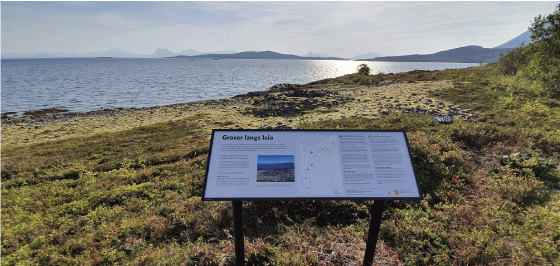
Figure 10.1 Upgraded burial ground at Bjarkøy.
An Iron Age burial site at Bjarkøy in the municipality of Harstad has received funding for maintenance and upgrading through the conservation programme Selected archaeological monuments, sites and environments.
Photo: Eva Sætersdal Walderhaug, the Directorate for Cultural Heritage
Source Source: State of the Environment Norway (figures from 2018 unless otherwise indicated) and the Directorate for Cultural Heritage
10.1.1 New preservation strategies
The preservation strategies will help structure, coordinate and organise the efforts so that the three new national goals are achieved, with a particular emphasis on the goal of maintaining a diversity of cultural environments. This includes initiatives and measures to improve the state of repair and level of maintenance, as well as measures to reduce losses and damage.
The preservation strategies will also take account of the fact that there are many different ways of maintaining the diversity of cultural environments. Furthermore, knowledge, experience, use and engagement are key goals that must be considered in the design of the preservation strategies.
Focus on topics
The purpose of the preservation strategies is to help ensure that the cultural environment reflects the cultural diversity in society. The topics around which the preservation strategies will be built shall be independent of the type of cultural environment and historical era. They shall ensure geographical, social, ethnic and industrial breadth.
Broad, coordinated use of instruments
The preservation strategies will consider all the available policy instruments in concert. The various instruments must be used such that together they safeguard the heritage assets in the cultural environment and contribute to the goal of maintaining diversity. This entails an integrated approach to protection pursuant to the Planning and Building Act and protection pursuant to the Cultural Heritage Act. Similarly, the different types of financial instruments must be considered in concert. The aim of the strategies is to promote interdisciplinary and cross-sectoral collaboration, knowledge and dissemination.
In connection with the preservation strategies, comprehensive overviews ought to be prepared for relevant categories of cultural environment or topics to ensure that the management authorities and researchers share a common knowledge base. This should in turn contribute to better coordination of priorities and measures.
The Directorate for Cultural Heritage will have the main responsibility for drawing up the preservation strategies and will strive to ensure good cross-sectoral collaboration in this work. The strategies will be implemented through collaboration between the Directorate for Cultural Heritage, the relevant directorates, the regional cultural environment authorities and other relevant parties. Collaboration and better coordination of the use of instruments will contribute to the preservation and use of cultural environments.
The Agricultural Landscapes of Special Interest scheme is a good example of coordination of different sectors’ financial and legal instruments and work in general (cf. box 10.4). In this scheme, directorates and regional authorities collaborate with municipal authorities and landowners. This initiative can provide good examples of an integrated approach to a topic where several authorities and administrative levels collaborate, and which may be relevant in the work of formulating the concrete elements of the preservation strategies.
Schedule and rotation
Work to identify relevant topics and develop the proposed preservation strategies should be started immediately, but it will take some time before the strategies are in place. At the same time, a considerable amount of work is already under way within the existing conservation programmes and the protection strategy, which are now in the process of being wound down. It will therefore be necessary to ensure a gradual phasing out of the existing programmes, parallel to the establishment of a new structure. In connection with this work, it will also be assessed whether to continue some of the current conservation programmes as ordinary grant schemes, and whether there is a need to adjust the rules for other grant schemes.
Targets and performance indicators shall be established for each preservation strategy to enable monitoring and reporting in relation to the priorities for the management of the cultural environment. Environmental monitoring and other governance data will be important instruments to assess the degree of attainment of the targets. The preservation strategies will be assessed periodically in view of their effectiveness towards attainment of the targets and to identify the need for any adjustments.
In the last fifteen years, the Directorate for Cultural Heritage has developed a number of targeted strategies: for vessels, urban environments, archaeological monuments and sites, and for work on cultural heritage in the municipalities. These targeted strategies will continue to be important, but they will need to be revised in order to align them with the new national goals and the work on the new preservation strategies.
10.2 Financial instruments
Various support and incentive schemes are essential for the ability to preserve a diversity of cultural environments in a long-term perspective. The cultural environment is an important common good. Although the main responsibility for taking care of private property lies with the owner, public instruments shall help ensure that the owners are capable of taking their share of responsibility for preserving a diversity of cultural environments.
The state has a number of different support schemes to cover additional expenses property owners incur as a result of requirements set by the cultural environment authorities. There are also schemes aimed at restoration and upgrades, and schemes to encourage the commercial use of cultural environments for value creation, business development, cultural tourism, and employment.
10.2.1 Grant schemes
Grant schemes are an important instrument to achieve the national goals in the cultural environment sector. Public grants can trigger other funding, increased civic involvement, and increased input from owners of cultural heritage, volunteers and others. This creates positive ripple effects beyond the conservation itself, such as direct and indirect commercial opportunities, development of skills in traditional crafts in a variety of areas, rising property values, local development, and added experiential value.
There are a number of grant schemes the purpose of which is to contribute to the preservation of a diversity of cultural environments and the knowledge resources that they represent. A large proportion of these grant schemes are funded via the Ministry of Climate and Environment’s budget and are mainly administered by the Directorate for Cultural Heritage and the Cultural Heritage Fund. In line with the principle of sectoral responsibility, grants are also provided for preservation of cultural environments via other ministries’ budgets.
Several county authorities and municipal authorities have established their own grant schemes, as have a number of NGOs. These are often funded in partnership with private foundations and funds (cf. boxes 8.2 and 8.3).
The use of grant schemes must be targeted, strategic and coordinated. The development of preservation strategies, with topic-based focus areas where all the policy instruments are viewed in concert, will be essential to ensure coordinated use of the financial instruments (cf. section 10.1.1).
Grant schemes from the Directorate for Cultural Heritage and the Cultural Heritage Fund
The Directorate for Cultural Heritage distributes grants for protected cultural monuments, sites and environments, including preserved vessels. The Directorate for Cultural Heritage also distributes grants for work on cultural heritage at the municipal level, for value creation projects, and to the World Heritage properties. In the wake of the Regional Reform, a larger part of the administration of the various grants has now been delegated to the regional cultural environment authorities, and the delineation of accounting items and guidelines must be reviewed and reformulated in an appropriate manner. The criteria for the grants will also need to be adapted to the new preservation strategies’ use of policy instruments (cf. section 10.1.1).
The Cultural Heritage Fund is a targeted grant scheme that provides support for the preservation of privately owned cultural monuments, sites and environments deemed worthy of preservation. In the last five years, the Cultural Heritage Fund’s grant funding has risen by 108 per cent, from NOK 46.5 million in 2014 to NOK 96.9 million in 2019. In the same period, the Directorate for Cultural Heritage’s grant funds increased by 35 per cent, from NOK 377.4 million in 2014 to NOK 511.1 million in 2019.
Climate change is bringing new challenges related to erosion, landslides and floods. This can lead to increased costs for maintenance and repairs and ought to have consequences for how the items in the accounts for grants will be formulated and used over the next few years. Various options for schemes that stimulate preventive maintenance ought to be explored. See also chapter 9.2.2 on adaptation to climate change in connection with land-use planning. Regular maintenance over time ensures better preservation as well as environmental and economic savings.
Costs related to the payment of finder’s fees (cf. section 13 of the Cultural Heritage Act) are also expected to rise significantly in the coming years. Private metal detecting has increased considerably in the space of a few years, and several museums and county authorities have reported a tenfold increase in the number of finds submitted from 2014 to 2019. There is a major backlog in the processing of applications for finder’s fees at the archaeological museums and the Directorate for Cultural Heritage. A cautious estimate suggests that payments of finder’s fees could amount to around NOK 2 million in the coming years.
Sectoral grants and other grant schemes
In addition to the cultural environment authorities’ own grant funds, various other ministries also have grants for preservation of the cultural environment. In line with the sector principle, the individual ministries are responsible for using their policy instruments to help achieve the national environmental targets. For example, the agricultural authorities administer a number of grant schemes linked to cultural monuments, sites and environments in agricultural landscapes (cf. box 10.2).
Rolling stock such as cars and trains, and publicly owned cultural monuments, sites and environments currently have limited opportunities for government grants. The transport sector has no dedicated grant schemes for rolling stock. There are limited grant schemes for many cultural monuments, sites and environments owned by municipal authorities or museums, at the same time as the maintenance backlog is large. In the follow-up to this white paper, a number of sector-specific initiatives will be implemented with a view to identifying needs and charting how existing grant schemes ought to be altered or adapted.
Textbox 10.2 Funding for cultural environments in the agriculture sector
The agriculture sector has a wide range of partnerships and instruments that are important for safeguarding cultural environment assets. The initiative Agricultural Landscapes of Special Interest is a scheme where environmental values linked to biodiversity and the cultural environment form an important basis for integrated use of policy instruments. In 2020, there are 46 cultural landscapes included in the scheme. The Ministry of Climate and Environment and the Ministry of Agriculture and Food co-fund the scheme, and some NOK 37 million has been allocated to this scheme in 2020.
Other instruments in the annual Agricultural Agreement such as Spesielle miljøtiltak i jordbruket [Special Environmental Measures in Agriculture] also contribute to the restoration and maintenance of cultural monuments, sites and environments. The maintenance of mountain summer grazing farms and other cultivated land is included in the Regional Environmental Programme. The annual Agricultural Agreement finances the continuation of agricultural interventions in the World Heritage properties West Norwegian Fjords – Geirangerfjord and Nærøyfjord and Vegaøyan – The Vega Archipelago .
Funds have been allocated via the Landbrukets utviklingsfond [Agricultural Development Fund] for commercial developments in agriculture, including investment and business development funds and funds via the development programme for agricultural and reindeer husbandry-based growth and value creation. Funds have also been allocated via the Landbrukets utviklingsfond [Agricultural Development Fund] for environmental subsidies through the grant scheme for commercial and environmental measures in forestry. The environmental grant can be given in areas where forestry is operated to preserve and further develop environmental assets linked to biodiversity, landscape, outdoor activities and cultural monuments, sites and environments.
Grants for archaeological investigations
In the Storting’s consideration of Document no 8:147 (2017–2018), the following request resolutions were passed:
In connection with the white paper on the cultural heritage sector, the Storting asks the government to conduct a review of the duty to cover the costs of investigations when farmers are required to conduct an inquiry pursuant to sections 9 and 10 of the Cultural Heritage Act, and to consider incorporating “extensions and construction of new agricultural buildings on ordinary farms” into the provision on “less extensive private projects” (Resolution 764).
The justification for the developer’s duty to cover the costs involved in investigating automatically protected monuments or sites, as set out in section 10 of the Cultural Heritage Act, is that the person who contributes to the loss of an environmental asset for their own benefit must compensate for this. The legal principles that underlie this justification are the same as for the “polluter pays principle”, which applies to the entire public management of the environment. However, it follows from section 10 of the Cultural Heritage Act that all or part of the costs of archaeological investigations shall be met by the State in connection with “less extensive private projects” or if there are “special reasons”.
The practice of this statutory provision in respect of “less extensive private projects” is based on a circular prepared in 2007 by the then Ministry of the Environment19. By contrast, no corresponding guidelines have been drawn up for “special reasons”.
The circular delimits the boundary between “less extensive private projects” on the one hand and public and “large private works” on the other, as follows:
If the purpose of the work is primarily of a commercial nature […] it will not normally be considered a less extensive project.
Norway’s agricultural policy is based on recognition of the fact that farmers are self-employed. The polluter pays principle and the current scheme means that works of a commercial nature, such as business activities, will not normally be considered a less extensive project. In line with this, the government therefore does not wish to make changes to the circular and the practice of the scheme.
Moreover, the government finds that this issue is problematic in only a limited number of cases. The state already covers the costs in some of these through established special schemes for agriculture. Figures from the Directorate for Cultural Heritage show that in the period 2015 to 2019, decisions have been made on exemption under the Cultural Heritage Act in approximately 110 agricultural cases. The agricultural industry has been required to cover the cost of mandatory archaeological excavations in only ten of these cases.
In view of this, the government does not wish to make changes to Circular T-02/2007 or in its implementation. Nevertheless, the government finds that there are grounds for looking into whether the agricultural industry is unduly burdened and assessing how this can be resolved by drawing up further guidelines for the “special reasons” (cf. section 10 of the Cultural Heritage Act).
10.2.2 Other financial instruments
Other types of private funding have not been developed and employed in the cultural environment sphere to any major extent to date. As part of the follow-up of this white paper, it will be examined in more detail how opportunities for other private sources of funding, such as revenues and donations, and participation from foundations, businesses, etc., can be increased.
Since the reform in 1992, the tax system has been based on the principles of broad tax bases, low rates, equal treatment, and symmetrical treatment of income and expenses. The tax rules must build on these principles. It also means that direct grants are considered to be a more targeted instrument for supporting specific interventions, as opposed to introducing general exemption rules. Support is both more visible and easier to measure when it is given as a direct grant.
In an Official Norwegian Report on a simpler value-added tax system (VAT) (NOU 2019: 11), the committee argues that in sum, a system with exemptions is more expensive than a flat rate. The committee’s proposal of a single, standard rate may entail lower VAT on goods and services, benefiting restoration and maintenance.
Property tax
Property tax is a municipal tax that municipal authorities can choose to introduce. It is levied on properties pursuant to the Property Tax Act. The Act allows the authorities to exempt both protected and other buildings from property tax if they have “historical value”. Of the 371 municipalities that had chosen to levy property tax in 2019, 252 had decided to exempt one or more buildings on application. This is a system that can help ensure the preservation of a diversity of cultural environments. The government wants to continue the system whereby any exemption from property tax is decided by the municipal authorities.
Textbox 10.3 Sector fees, revision of the terms and conditions of licences, and renewal of licenses to use water resources
In 2010, the then Ministry of the Environment prepared guidelines on the use of sector fees for the protection of cultural heritage in watercourses in collaboration with the Ministry of Petroleum and Energy. The scheme applies to applications for the renewal or revision of the terms and conditions of licences originally granted before 1960, when no archaeological investigations were carried out in connection with the development of watercourses. The purpose of the scheme is to provide new knowledge about automatically protected cultural monuments and sites in regulated watercourses in connection with the revision of terms and conditions of licence or renewal of licences. The sector fees are intended to cover expenses related to implementing measures to safeguard the scientific value of the cultural monuments and sites, as this is defined in the Cultural Heritage Act.
In connection with the revision of the terms and conditions of licence or renewal of a licence, the licensee is ordered to pay a sector fee. The Norwegian Water Resources and Energy Directorate (NVE) calculates and collects this fee. The grants are allocated by the Directorate for Cultural Heritage. The Directorate for Cultural Heritage decides the priority of the scope of the investigations and the regulated watercourses in which investigations are to be carried out, but the investigations are carried out by the archaeological museums, the county authorities and the Sami Parliament.
Regulatory licences are granted with standardised sets of terms and conditions. Since 1960, archaeological investigations have been carried out in connection with the granting of licences. These licences are therefore not covered by the sector fee system.

Figure 10.2 Measuring and registration of stones with rock carvings along the shores of Lake Selbusjøen in Trøndelag.
Through the project Selbusjøen as a transport artery and ritual landscape in the Bronze Age, which was funded by sector fees, some twenty-odd rock carvings were registered and studied. Most are underwater for much of the year, but it is likely that they were also underwater in periods in the past.
Source Photo: Anne Haug, Trøndelag County Authority
10.3 Collaboration and coordinated use of policy instruments
Attainment of the national goals will require greater collaboration and coordinated use of policy instruments. Ensuring the preservation of a diversity of cultural environments is a shared responsibility.
10.3.1 Collaboration with private stakeholders and organisations
Owners of cultural heritage and volunteers make an invaluable contribution to the work of preserving a diversity of cultural environments. Their efforts do much to advance the work towards achieving the national goals and are crucial for enabling the use and preservation of the cultural environment. Good collaboration between the authorities and owners of cultural heritage, volunteers and NGOs is important both to ensure continued use, maintenance and upkeep of tangible heritage, but also for coordination and development related to intangible cultural heritage.
One of the goals of the Regional Reform is to strengthen collaboration at the regional and local levels. The government also wants to strengthen collaboration between the cultural environment authorities and owners of cultural heritage, volunteers and NGOs. The new preservation strategies will be an important framework for this kind of collaboration in the future. Local collaboration, at both the county and the municipal level, must also be further developed. This is discussed in more detail in sections 8.2 and 9.2.
10.3.2 Interdisciplinary partnerships
The principle of sector responsibility is the backbone of collaboration on environmental issues in the public sector. This responsibility is set out in the white papers on environment and development in 1989 (St.meld. nr. 46 (1988–89)) and on environmental protection policy for sustainable development in 1997 (St.meld. nr. 58 (1996–97)). The environmental authorities are responsible for coordinating the government’s efforts to set and monitor implementation of national environmental targets within the various sectors in the central government, while the actual work towards the environmental targets is carried out under the auspices of the various responsible sector authorities. The principle of sectoral responsibility means that each sector has a responsibility to take care of its own cultural monuments, sites and environments and that they must take the cultural environment into account in their activities.
There is already a well-established collaboration at the national level between the cultural environment authorities and other relevant sectors. In order to strengthen interdisciplinary collaboration, the government wants to develop the established partnerships between the various sectors.
Several ministries are responsible for cultural heritage policy. In order to facilitate collaboration and make it easier to see the management of tangible and intangible cultural heritage in context, an inter-ministerial cultural heritage forum will be established, based on the model of the Inter-Ministerial World Heritage Forum and the Inter-Ministerial Landscape Group. The Landscape Group was established in 2004 to follow up the European Landscape Convention. The World Heritage Forum was established in 2018 as part of the follow-up of initiatives proposed in the white paper on the management of cultural heritage in 2013 (Meld. St. 35 (2012–2013)). The results so far have been very good.
Nature management
Integrated environmental management requires good interaction between the parties responsible for the management of the cultural environment and those responsible for the management of the country’s natural resources. Closer interaction between the environmental authorities and relevant sectors will help ensure a good balance between different social considerations in land-use management. This will help strengthen both cultural environment and nature management interests.
The collaboration between the cultural environment authorities and the nature management authorities is therefore a good starting point for further development and coordination with other sectoral interests as well. Examples of this collaboration include landscape issues, outdoor activities, the establishment and management of protected areas, visitor centres, and implementation of the World Heritage Convention.
In connection with efforts to strengthen coordination and collaboration, it will be important to identify shared needs for knowledge as a basis for future mapping, monitoring and research, and as a basis for better coordination in overarching planning. Another important area will be collaboration linked to developing common information and guidance materials and in order to develop good routines for collaboration across administrative levels. Changes in land use, which, according to the Intergovernmental Science-Policy Platform on Biodiversity and Ecosystem Services (IPBES) are the main driver of biodiversity loss, will be a challenge and may also pose a major threat to important cultural heritage.
The agricultural sector
The collaboration with the agricultural authorities has evolved over the last 30 years and has resulted in, among other things, the national inventory of valuable cultural landscapes, the Norwegian monitoring programme for agricultural landscapes (the “3Q Programme”), and the scheme Agricultural Landscapes of Special Interest (cf. box 10.4). The agricultural sector’s sectoral responsibilities were most recently emphasised in a report in 2015 on environmental instruments in agricultural policy20.
Textbox 10.4 Agricultural Landscapes of Special Interest
The agricultural landscape has been created through settlement and use of the landscape over several thousand years. It comprises burial mounds, buildings, stone walls, roads, fields, meadows, pastures, heather-clad moors and coppices for fodder. The landscape as a whole, with farmyards, cultivated fields and outlying fields, represents a site with high cultural-historical and biological value.
In 2006, the Directorate for Cultural Heritage, the Norwegian Agricultural Authority (now the Directorate of Agriculture) and the Directorate for Nature Management (now the Norwegian Environment Agency) were given a joint assignment that ended up resulting in the initiative Agricultural Landscapes of Special Interest in 2009. In 2020, 46 landscapes will be included in this scheme. NOK 37.3 million has been allocated to the scheme in 2020. Starting from 2020, the administration of this grant scheme has been handed over to the relevant municipal authorities.
The purpose of grants for initiatives in Agricultural Landscapes of Special Interest is to help safeguard assets related to the landscape, biodiversity, cultural monuments, sites and environments. These assets require long-term care and maintenance. The scheme has had a high level of attainment of goals. The areas must look like well-tended agricultural landscapes with the least possible degree of disruptive elements or influence from recent times. The selected landscapes shall constitute an exclusive selection that can serve as national reference areas and “showcases”, entailing a number of obligations for the central government, counties and municipalities. The commitment and involvement of the landowners and the local community is fundamental. In this initiative, the agricultural, nature management and cultural environment authorities have joined forces to preserve important assets in collaboration with landowners and operators.
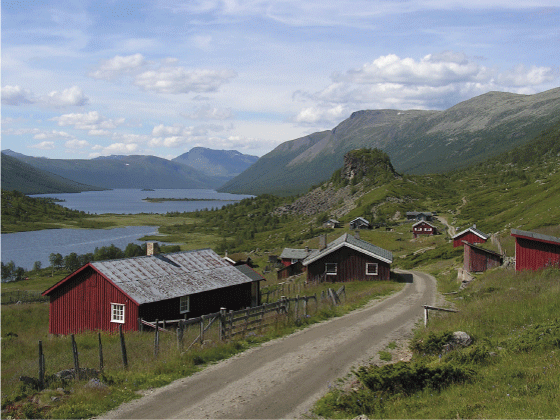
Figure 10.3 Stølsvidda is part of the Agricultural Landscapes of Special Interest scheme.
Stølsvidda, a plateau in the mountains between Valdres and Hemsedal, is the area of Norway and Europe that has had the most extensive mountain summer grazing and dairy farming. The area still has the largest concentration of active mountain summer dairies in Norway. Mountain summer dairy farms have been operated here since the late Middle Ages.
Source Photo: Kari Stensgaard
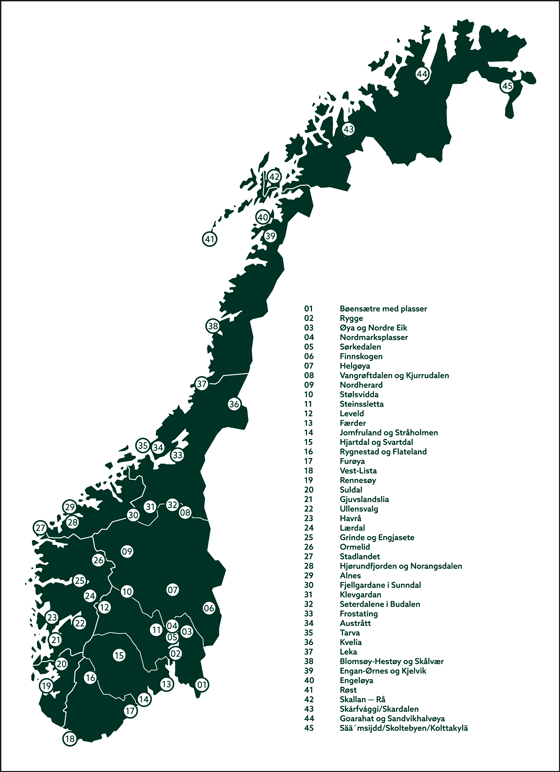
Figure 10.4 Map of the Agricultural Landscapes of Special Interest in 2020.
Source Source: The Directorate of Agriculture, the Norwegian Environment Agency and the Directorate for Cultural Heritage
The cultural sector
Tangible and intangible cultural heritage are inextricably interlinked. Good management of tangible and intangible cultural heritage depends on stronger collaboration between the cultural environment authorities and the cultural and museums sector. The museums sector plays a central role in linking the tangible (physical places and objects) and the intangible in the form of stories, artefacts and traditional craftsmanship.
The 15 selected national technical and industrial facilities are examples of the significance of good coordination between the sectors. These are cultural monuments and sites that receive both grants from the Directorate for Cultural Heritage and funding via the Ministry of Culture’s budgets. The purpose of better coordination is to enable more integrated management by ensuring that grant schemes and other instruments are working towards the same goals, and to facilitate efficient management of the grants.
Other examples of areas with potential for increased coordination and development include the management of collections and digital infrastructure, arts and culture as an arena for the development of sustainable solutions, and museums as stewards of historical buildings and cultural environments. The Regional Reform also paves the way for closer collaboration between the cultural environment authorities and the museums at the regional level.
The state as an owner
The state owns and manages a broad range of properties of cultural-historical value. Taking good care of these properties is a major responsibility, and it is paramount that the state sets a good example. The project Statens kulturhistoriske eiendommer [State Cultural Historic Properties] (the SKE project) was started up in 2002 and is an example of how sectoral responsibilities contribute to ministries and their underlying agencies and enterprises assuming responsibility for meeting the environmental targets within their own areas of responsibility. The project was adopted in the Royal Decree of 1 September 2006 about the management of the state’s cultural historic properties, which instructed all the central government agencies to draw up a national protection plan for their properties of cultural-historical value, and a management plan for each of these properties. This entailed registering and documenting all the properties they owned and assessing their cultural-historical value.
The project resulted in two categories of protection: buildings and facilities in Grade 1 are protected under the Cultural Heritage Act, while Grade 2 encompasses properties that the sector will preserve itself in some other way than through formal protection, i.e., self-imposed preservation within the sector. The responsibility for the follow-up of Grade 2 listed properties lies with the sector or the state enterprise itself. The degree to which this responsibility has been followed up varies widely.
With a view to ensuring the preservation of Grade 2 listed cultural monuments, sites and environments through the Planning and Building Act, they shall be registered and made available in Askeladden, the official national database for cultural monuments, sites and environments, such that their heritage status follows the site itself, as opposed to depending on who owns it. In this way, the municipal authorities will be able to retrieve information from Askeladden in their ordinary planning processes and take these cultural monuments and sites into account in municipal master plans and zoning plans. The county authorities and the Sami Parliament must incorporate land-use objectives and provisions that regulate them in their planning processes (cf. sections 11-8, 11-9 and 12-7 of the Planning and Building Act).
After almost 20 years, there is now a need to evaluate the central government’s national protection plans and the management of the properties in general. State Cultural Historic Properties (SKE) has been a pioneering project that has generated a broad empirical foundation related to management and exemption practices. Through this project, several of the sectors have gained good knowledge of their sector’s history and cultural environments, and routines for managing them. It is important that this knowledge is institutionalised and that the sectors have their own plans for how they can contribute to achieving the new national goals for the cultural environment. The management plans are useful tools in this respect, and it is important that they are implemented in practice, as this will ensure predictable management of the properties.
In recent years, several major state institutions have moved out of their premises. Some of these buildings are of great cultural-historical value. Through the royal decree, the state is obliged to manage its properties deemed worthy of preservation properly, even after it has vacated the building. When state institutions move out of buildings of high cultural-historical value, the state must continue to bear the financial responsibility for the buildings for as long as the state still owns the property21. It is therefore important that the state has clear, realistic plans for the reuse and management of its buildings of cultural-historical importance before a state institution moves out.
When state-owned buildings that are subject to preservation are sold to private buyers, it is important that the state sets requirements to the buyer concerning the management of the buildings. The provisions concerning protection apply regardless of whether all or only part of a protected building or facility goes out of state ownership. The owner is thus responsible for ensuring that the Directorate for Cultural Heritage is informed well in advance of the transfer of ownership (cf. section 1-6 of the State Cultural Historic Properties (SKE) Regulations).
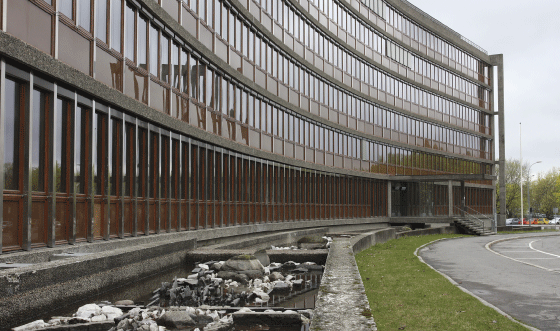
Figure 10.5 Rehabilitation of the protected Norwegian Water Resources and Energy Directorate (NVE) Building.
The rehabilitation of the protected NVE Building in Oslo, the head office of the Norwegian Water Resources and Energy Directorate, demonstrates how use and protection can be combined. The building was totally renovated in 2008–2011. The result is a good example of how it is possible to combine the interests of preservation, modernisation, improving energy efficiency (to energy class B), the environment and universal design, in an existing protected building.
Source Photo: Siri Wolland, the Directorate for Cultural Heritage
Church management
Church buildings, including their surroundings and interiors, are an important part of Norway’s cultural heritage. The churches provide information about one thousand years’ worth of cultural history in the fields of architecture, art and crafts. For a thousand years, churches have been built and decorated in nearly every local community. Church buildings are often an important landmark and a central element in a place’s local identity. Church buildings are also a testimony to a spirit of community and voluntary work, as many of the churches were built by the local community.
In 2012, the Storting amended the provisions in the Constitution, which had regulated the state church system since 1814. An administrative reform formalised the separation of church and state in 2017. Both the legislation on the Church of Norway and provisions concerning the organisation of the church and the distribution of responsibilities within the church are in the process of being revised. The changes will have implications for the future safeguarding of the cultural-historical values that church buildings represent.
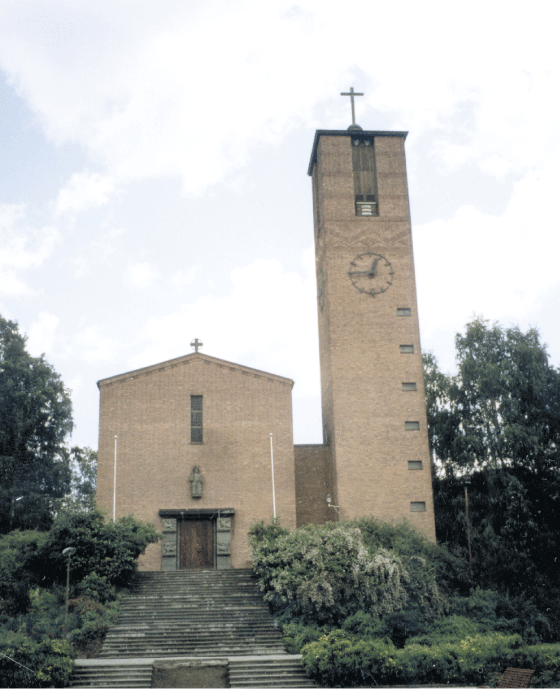
Figure 10.6 Notodden Church.
The church was built in 1938 and designed by architects Dagfinn Morseth and Mads Wiel Gedde. The church is a listed building. A listed building is a building that has been designated a cultural monument worthy of preservation by the Directorate for Cultural Heritage.
Source Photo: Ingrid Djupedal, the Directorate for Cultural Heritage
The current Church Act contains provisions concerning church buildings. More detailed provisions have been stipulated in a circular on the management of church buildings, graveyards and church surroundings as cultural monuments, sites and environments. Both the Church Act and the Circular on Churches will be repealed by the proposed new Act relating to religious communities (the Religious Communities Act) (cf. the bill Proposition no. 130 L (2018–2019), which is scheduled to come into force from 1 January 2021). Transitional rules will be drawn up to ensure the preservation of the cultural-historical assets in church buildings. However, more lasting arrangements will eventually need to be established. There is good cooperation on church buildings between the relevant ministries, ecclesiastical bodies and the Directorate for Cultural Heritage.
Many of the churches have a considerable maintenance backlog. Expenses related to the church buildings are a municipal responsibility; but in many places, a considerable amount of voluntary work is done through organised volunteer drives, etc. In addition, the Norwegian Association for Church Employers (KA) carries out regular registrations of the state of church buildings and has built up a database of documentation about the individual churches and their interiors. The purpose of the Church Building Database is to provide local church administrators with a professional, standardised tool for building management. The database contains all the buildings that are churches pursuant to the Church Act or that have been consecrated for ecclesiastical use. All public burial sites have also been added to the database. It is used by ecclesiastical bodies, as well as other parties involved in the management of church buildings, including the Directorate for Cultural Heritage and the Norwegian Institute for Cultural Heritage Research (NIKU).
In the white paper on the Norwegian church endowment (Ovf) in 2019 (Meld. St. 29 (2018–2019)), the government decided to give a significant boost to securing church buildings of cultural-historical value. This is expected to help resolve many of the major maintenance challenges that church buildings face.
Through the Regional Reform that came into force on 1 January 2020, the Directorate for Cultural Heritage has until further notice retained the management of the protected and listed churches, while the responsibility for management of the medieval churches outside the four major medieval towns (Oslo, Tønsberg, Trondheim and Bergen) has been transferred to the county authorities.
Textbox 10.5 The defence sector
Significant cultural assets come under the Ministry of Defence’s sectoral responsibilities. The Norwegian Defence Estates Agency is responsible for 14 national fortresses and several border fortification posts. The Norwegian Defence Estates Agency is also making arrangements for new use of areas and buildings inside the fortresses that the defence sector no longer uses. The Armed Forces’ continued presence at the fortresses helps keep the military heritage alive.
New services and experiential offerings have been established in partnership with municipal authorities, “friends of” associations, investors, and private stakeholders in the culture and commercial sectors. Over a period of ten years, this has contributed to an increase in visitors from 1.9 million visits in 2009 to 4.2 million visits in 2018. In addition to developing the fortresses as attractive venues for historical and cultural dissemination, tourism and recreation, the fortresses are protected, national cultural environments and important for the Norwegian Armed Forces.
In addition to the historical fortresses, the Norwegian Armed Forces has an extensive preservation plan that underscores the importance of the Norwegian Armed Forces in Norway in a historical perspective. The selection of protected defence facilities ranges from historical castles and fortresses to remnants from the Cold War. To date, a total of 67 facilities, including the 14 national fortifications, are subject to some form of protection. Within these sites, some 1,400 different types of buildings, fortifications, etc., are subject to protection, most through protection orders.
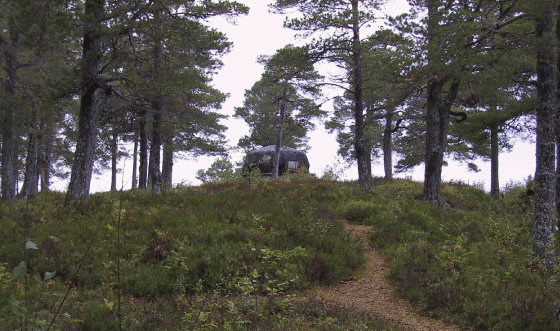
Figure 10.7 Hegra Fortress in the municipality of Stjørdal.
The fortress consists of trenches, tunnels, passageways, living quarters, and command towers. The area is a popular hiking destination.
Source Photo: Hege Søstrand Bu, the Directorate for Cultural Heritage
10.4 Legislation
The Act concerning the cultural heritage (the Cultural Heritage Act), the Act relating to planning and the processing of building applications (the Planning and Building Act) and the Act Relating to the Management of Biological, Geological and Landscape Diversity (the Nature Diversity Act) are important legal instruments for the preservation of a diversity of cultural environments.
10.4.1 The Cultural Heritage Act
The current Cultural Heritage Act was adopted on 9 June 1978. It has since been amended several times, including revision of the purpose clause and changes to the definitions, and in 1992 the concept of the “cultural environment” was introduced. The Act nevertheless reflects the fact that it is an amalgamation of two older Acts: the Ancient Monuments Act (1951)22 and the Building Protection Act (1920)23. Although some of provisions of the Cultural Heritage Act have been amended since 1978, there has been no systematic review of the Act as a whole. The government therefore wants to formulate a new Act that is up to date and better adapted to today’s challenges.
The need for a new Act on cultural heritage was first identified in an action plan for cultural heritage management in 199224. The need was highlighted again in the Official Norwegian Report on challenges in a new cultural heritage policy in 2002 (NOU 2002: 1), which called for preparation of a new cultural heritage Act. Among other things, it was pointed out that certain linguistic challenges in the Act allowed for different interpretations, potentially leading to not everyone experiencing equality before the law. In addition, shortcomings linked to the structure and system of the Act were highlighted.
Both administrative law and the organisation of the public authorities have undergone major changes since 1978. In addition, increased digitalisation presents new challenges and opportunities that the legislation ought to take into account. One digital public sector – Digital strategy for the public sector 2019–2025 highlights the need to look at the relationship between processes, technology and regulations.
In the work on the new Act, it will also be necessary to investigate the question of the authority of the Sami Parliament under the Cultural Heritage Act, including how authority is to be transferred. In addition, it ought to be assessed whether the safeguarding of national minorities’ cultural monuments, sites and environments is sufficiently addressed.
Norway has also ratified a large number of international conventions that have implications for the formulation of legislation and management in the cultural environment sector (cf. section 7.2). Examples include the Valletta Convention, the European Landscape Convention and the Faro Convention, as well as the Convention on the Means of Prohibiting and Preventing the Illicit Import, Export and Transfer of Ownership of Cultural Property. Although adjustments have been made to the legislation to meet the obligations that follow from these treaties, the government finds that a comprehensive review and assessment of the Act is now necessary.
Moreover, several Acts have been developed and revised in the 2000s that have implications for the management of the cultural environment. The main ones in this respect are the Planning and Building Act (2008) and the Nature Diversity Act (2009). These Acts, and the proposed new Religious Communities Act, further underscore the need for a review of the current Cultural Heritage Act. A completed evaluation of the planning part of the Planning and Building Act (EVAPLAN) recommends, among other things, that the Cultural Heritage Act undergo an extensive revision, with the aim of improving the coordination between the Cultural Heritage Act and the planning system.
The government wants to draft a new Cultural Environment Act that will replace the Current Cultural Heritage Act from 1978.
10.4.2 The Planning and Building Act
The Planning and Building Act is an overarching, cross-sectoral law that governs land use and zoning in Norway. It is thus also the main Act regulating issues related to preserving a diversity of cultural environments. The municipal authorities have a key role through the decision-making authority assigned to them under the Planning and Building Act. Planning pursuant to the Planning and Building Act shall stimulate and coordinate physical, environmental, economic, social, cultural and aesthetic development of municipalities and regions and ensure that the citizens have the opportunity to influence local planning and development.
As part of the Planning and Building Act’s overall sustainable development goals, social and land-use planning shall specify how social needs are to be met, while safeguarding valuable land resources, natural and cultural environments, and landscapes. This includes, among other things, the conservation and protection of natural areas for the outdoor recreation. The plans must also serve to implement international conventions and agreements within the scope of the Act, such as the World Heritage Convention, the Valletta Convention, the European Landscape Convention and the Faro Convention. Plans shall promote an integrated approach, coordination and collaboration, help resolve tasks across sectoral and administrative boundaries, and be a tool for achieving a good balance between public needs and frameworks and private activities and wishes.
The Planning and Building Act has high legitimacy, but the evaluation project EVAPLAN recommends that its coordination with the various sector laws be improved (cf. section 9.2).
10.4.3 The Nature Diversity Act
Areas shaped by humans and culturally adapted species are an important part of Norwegian nature. Many areas are defined by a combination of both natural diversity and cultural environment. Historically, these two aspects have been separated, even within a single area, and handled differently as part of the management of nature and the cultural environment, respectively. Effort has been made to safeguard cultural environment assets in protected areas through separate provisions in the Nature Diversity Act. By contrast, natural diversity is not currently regulated in the Cultural Heritage Act. Through the adoption of the Nature Diversity Act in 2009, amendments to the Cultural Heritage Act were also adopted, which now allow for basing protection under the Cultural Heritage Act on biodiversity linked to the cultural environment.
The purpose of the Nature Diversity Act is “to protect biological, geological and landscape diversity and ecological processes through conservation and sustainable use, and in such a way that the environment provides a basis for human activity, culture, health and well-being, now and in the future, including a basis for Sami culture”. The concrete actions and instruments to achieve these goals are described in Chapters III – VII, in addition to the general provisions on sustainable use in Chapter II.
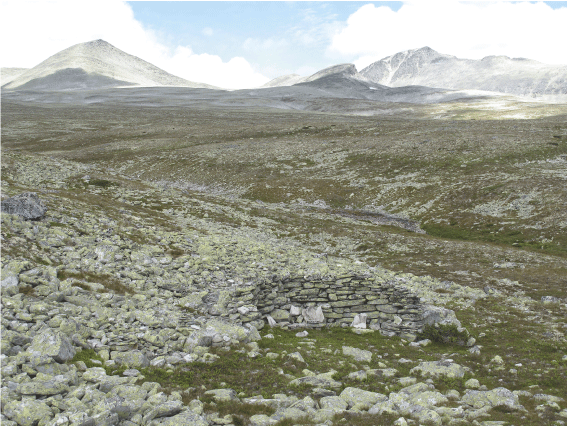
Figure 10.8 Humanity’s use of nature.
A seemingly untouched natural landscape in Rondane National Park containing a number of traces of past eras’ activities. This picture features a stone hide. These kinds of hides were often used as part of a larger hunting and trapping system.
Source Photo: Elisabet Haveraaen, the Ministry of Climate and Environment
Cultural heritage and cultural landscapes are covered by the provisions on protected areas in Chapter V. Among other things, it is stated that protected areas shall promote the conservation of the full range of variation of habitats and landscape types and natural environments that reflect human use through the ages (cultural landscapes) or that are also of historical value, in addition to the facilitation of forms of use. Protected areas on land can also contribute to the conservation of ecological and landscape coherence at the national and international level.
In national parks, cultural-historical qualities are protected against intervention, both by the fact that this is prohibited directly by the Act, and by the fact that the Act requires that regulations on protected areas protect cultural monuments and sites from intervention.
“Protected landscapes” are “natural or cultural landscapes that are important in ecological or cultural terms, as a source of enjoyment or as a basis for forming an identity”. This category of protection includes cultural monuments and sites that contribute to the distinctive character of a landscape as part of the landscape. In this context, cultural monuments and sites include old summer grazing farms in mountain pastures, fisherman’s cabins in coastal landscapes, and trapping pits in mountainous landscapes. “Cultural qualities” include both elements that have cultural-historical value and current use as the basis for cultural development. Examples include traditional activities in the area that are manifest in physical marks on the landscape, such as rounding out agricultural areas, old buildings, stone walls, etc.
Regulations on the protection of nature reserves may contain provisions on the protection of cultural monuments and sites. In recent years, the category “nature reserve” has mainly been used to ensure the protection of forests and some wetlands, and certain coastal landscapes. In addition to provisions prohibiting most types of interventions and activities that may harm the natural diversity, recent regulations have also contained provisions regarding protection of the cultural monuments and sites in connection with access to the reserve and the duty to apply for permission to maintain or restore cultural monuments, sites and environments.
10.5 Follow-up
The government will
develop preservation strategies for priority topics
This will in part be done by:
identifying which topics should be prioritised in the preservation strategies
establishing targets and performance indicators for each preservation strategy
coordinate financial instruments
This will in part be done by:
assessing whether any of the current conservation programmes should be continued as ordinary grant schemes
identifying needs and clarifying responsibilities for grant schemes in dialogue with other sectors
preparing guidelines on the “special reasons” (section 10 of the Cultural Heritage Act)
strengthen interdisciplinary collaboration
This will in part be done by:
establishing an inter-ministerial forum on cultural heritage
continuing the collaboration on the scheme Agricultural Landscapes of Special Interest and assessing increasing the number of areas within the existing frameworks
evaluating the central government’s national protection plans and their management
draft a new Cultural Environment Act
Footnotes
Goth, Ursula S. and Erik Småland 2014. The Role of Civic Engagement for Men’s Health and Well Being. Int. J. Environ. Res. Public Health 2014, 11.
Circular dated 27 September 2013 (amended on 20 May 2014) on simpler and faster processing of applications for exemption for work on structures, facilities, etc. from recent eras and areas and cultural environments that are protected pursuant to the Cultural Heritage Act. The Directorate for Cultural Heritage.
Market report 2-19. The Federation of Norwegian Construction Industries (BNL).
Menon Economics 2017, Kulturminnefondets samfunnsnytte [The benefit to society of the Norwegian Cultural Heritage Fund], Menon publication 42/2017.
From the IEA report Transition to Sustainable Buildings, published in SINTEF Fag 58, 2019, Miljøvurdering ved oppgradering av verneverdig bebyggelse [Environmental assessment in connection with upgrading buildings deemed worthy of preservation], p. 13.
The Intergovernmental Panel on Climate Change (IPCC) fifth Assessment Report, AR5, 2014, p. 690.
Asplan Viak, 2016, Klimagassberegninger Villa Dammen [Calculated greenhouse gas emissions for Villa Dammen].
Miljøvurdering ved oppgradering av verneverdig bebyggelse [Environmental assessment in connection with upgrading historic buildings], SINTEF Fag 58, 2019.
Bærekraftig klimaforbedring av eldre Hus [Sustainable upgrades to improve the climate performance of old buildings]. The National Trust of Norway, Report dated 24 January 2019.
The New Urban Agenda was adopted at the United Nations Conference on Housing and Sustainable Urban Development (Habitat III) in Quito, Ecuador, in 2016.
Getting cultural heritage to work for Europe. Report of the Horizon 2020 Expert Group on Cultural Heritage. European Commission, Directorate-General for Research and Innovation, 2015.
Cultural Heritage Counts For Europe. CHCfE Consortium, 2015.
Material Cultural Heritage as a Strategic Territorial Development Resource: Mapping Impacts Through a Set of Common European Socio-economic Indicators, Final Report, 27 September 2019, ESPON.
Menon Economics 2017, Verdien av kultuarv. En samfunnsøkonomisk analyse med utgangspunkt i kulturminner og kulturmiljøer [The value of cultural heritage. A socio-economic analysis of cultural monuments, sites and environments]. Menon publication no. 72/2017.
Oslo Economics 2017, Vern gjennom bruk – Hva hindrer næringsvirksomhet med utgangspunkt i kulturminner? [Preservation through use – What are the obstacles to business activities based on cultural heritage?]
Strategi for kultur og reiseliv. Norge som attraktiv kulturdestinasjon [Strategy for culture and tourism. Norway as an attractive cultural destination], 2019.
EVAPLAN was carried out in the period 2014–2018 and has been led by the Norwegian Institute for Urban and Regional Research (NIBR-HiOA), in collaboration with several universities, university colleges and research communities in Norway and other Nordic countries.
National Budget for 2020 (Prop. 1 S (2019–2020)) Budget proposal for the fiscal year 2020, the Ministry of Climate and Environment, Appendix 1.
Rundskriv T-02/2007 [Coverage of the costs of archaeological works in connection with less extensive private projects] Dekning av utgifter til arkeologiske arbeider ved mindre, private tiltak.
Helhetlig gjennomgang av miljøvirkemidler i jordbrukspolitikken [Comprehensive review of environmental instruments in agricultural policy]. Report from a joint working group for the 2015 Agricultural Agreement, 23 February 2015.
This issue is addressed in a report about the forgotten cost of state newbuilds (Concept/NTNU, Den glemte kostnaden når staten bygger nytt, Arbeidsrapport 2018-2) and the study conducted by Statsbygg (Samfunnsøkonomisk analyse AS, Fredede og verneverdige bygg i KVU/KS1, Rapport nr. 03-2019).
The Ancient Monuments Act («Fornminneloven») of 26 May 1951, which in turn replaced the Act on the Protection and Preservation of Antiquities («Lov om Fredning og Bevaring av Fortidslevninger») from 1905.
The Building Protection Act of 9 January 1920.
Handlingsplan for kulturminneforvaltningen (Action plan for cultural heritage management). T-891, the Ministry of the Environment, 1992.